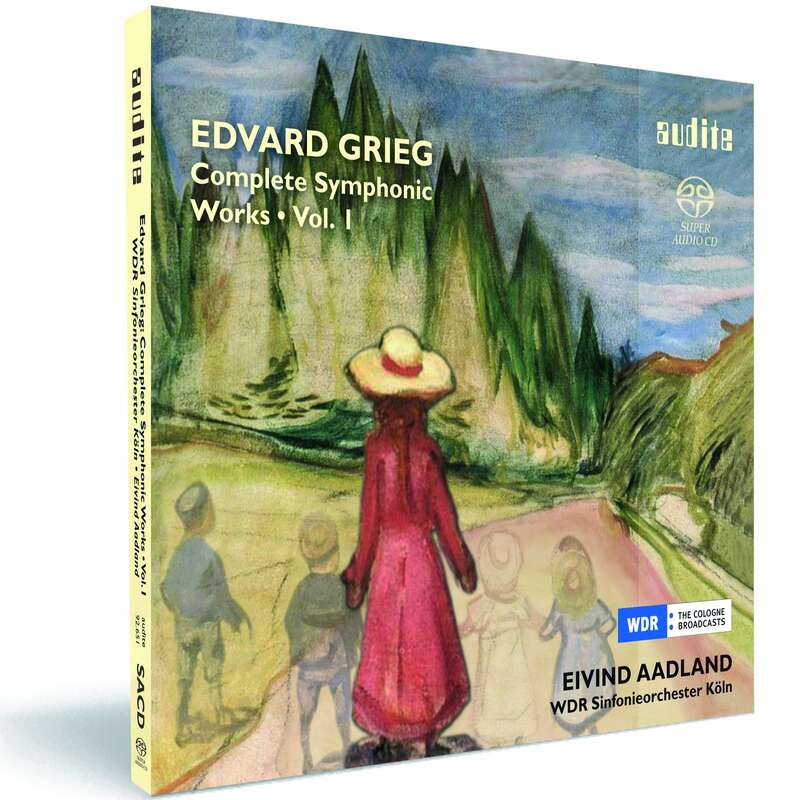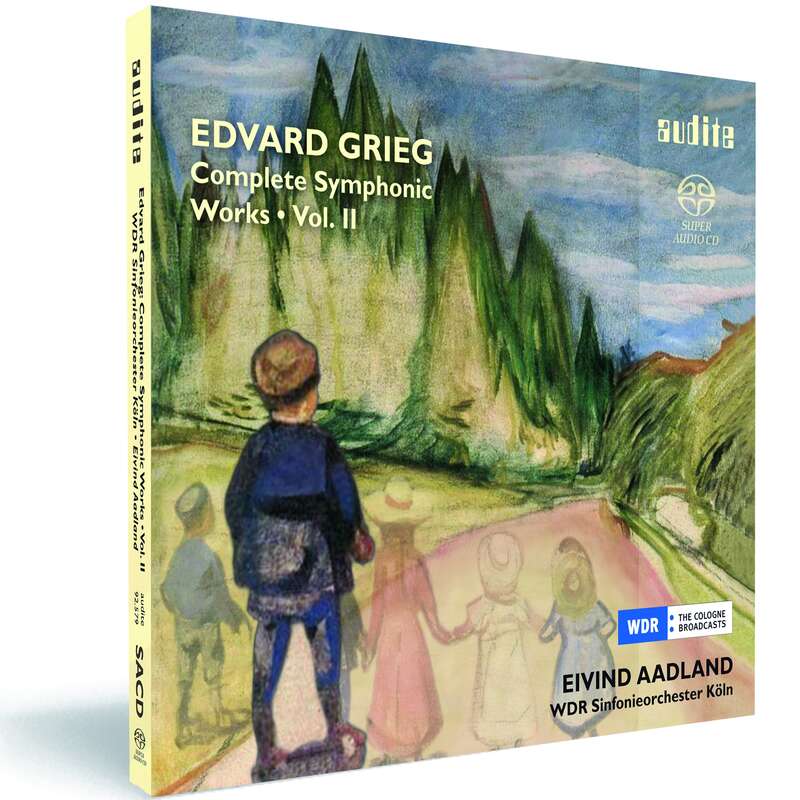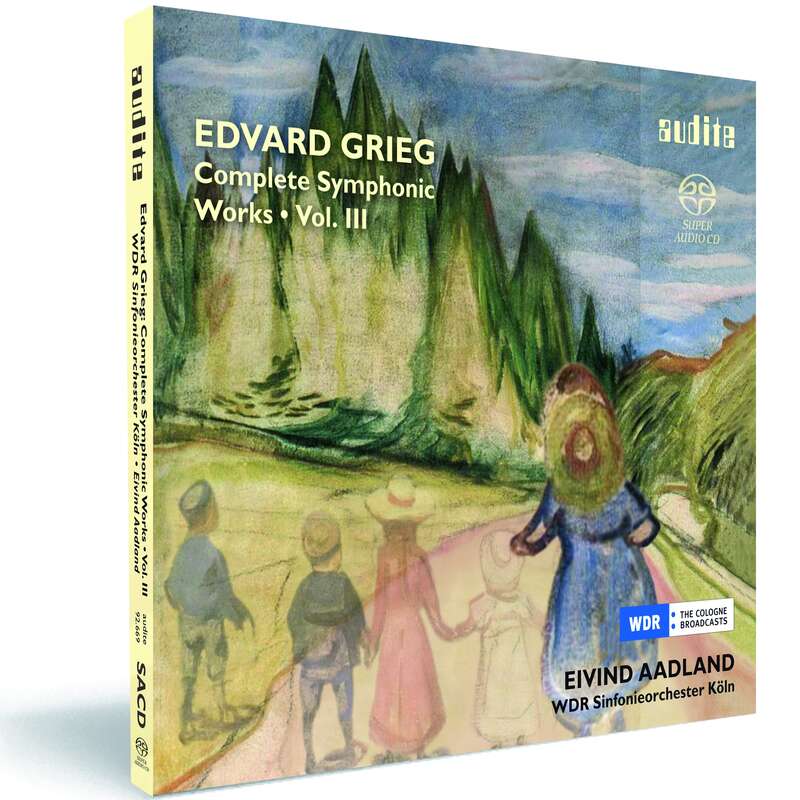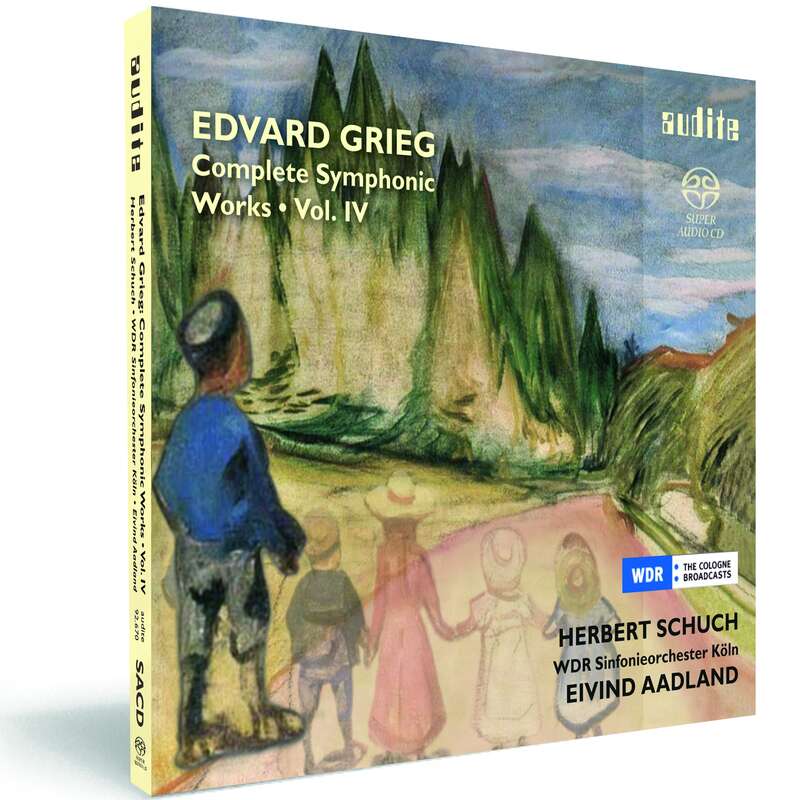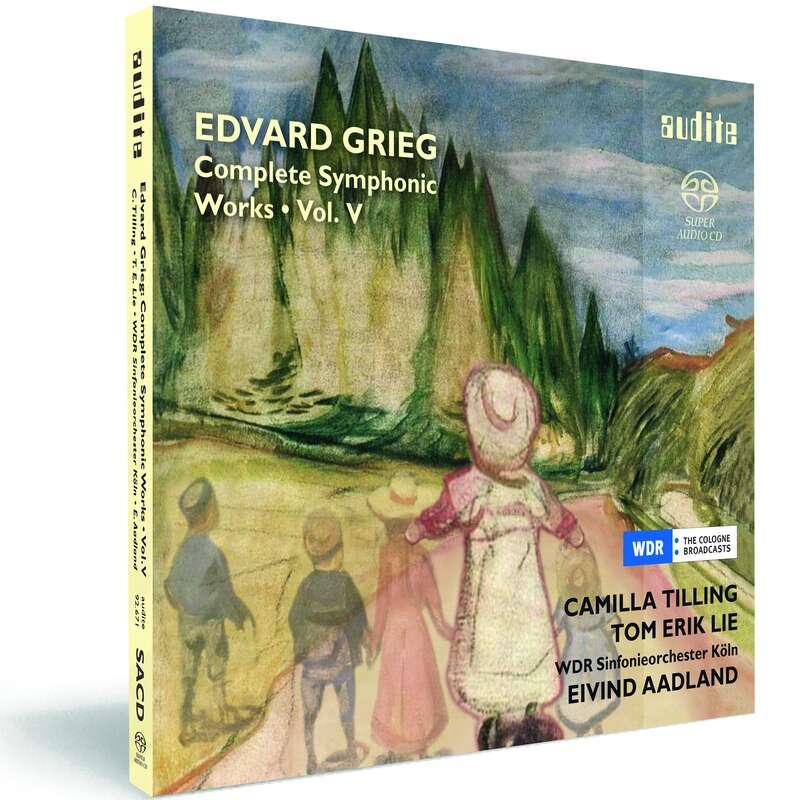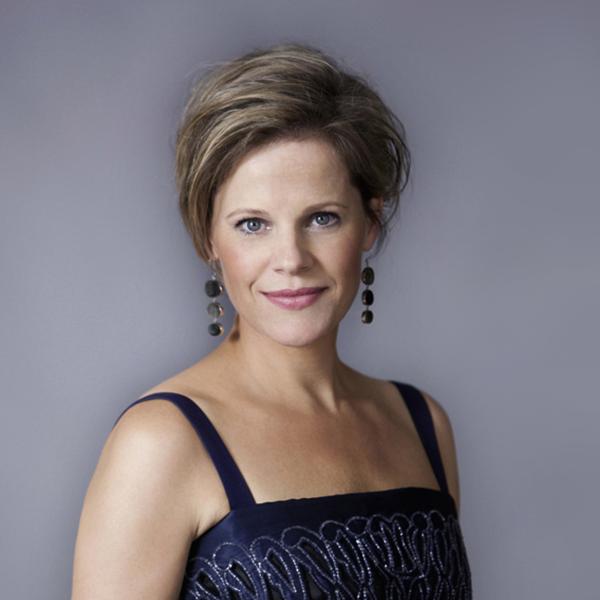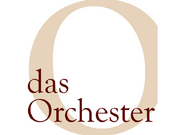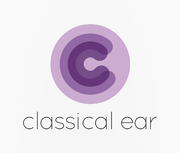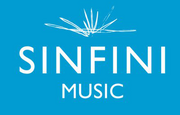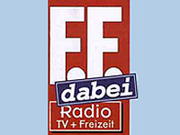This complete edition of the symphonic works of Edvard Grieg, in five parts altogether, is especially convincing thanks to the authentic approach of the Norwegian Eivind Aadland, who strongly influences the interpretations of the WDR Symphony Orchestra Cologne under his direction. Volumes 1 and 2more
Edvard Grieg was the voice of Norway in the nineteenth century, ringing out across the whole of Europe. His Symphonic Dances Op. 64 use authentic melodies and rhythms from the Norwegian mountains, whilst Grieg’s incidental music for Henrik Ibsen’s drama Peer Gynt is characterised by more diverse writing. From the world-famous string line in Morning Mood to the wild chase in the Hall of the Mountain King, Grieg demonstrates every facet of his orchestral skills.
Track List
Informationen
This complete edition of the symphonic works of Edvard Grieg, in five parts altogether, is especially convincing thanks to the authentic approach of the Norwegian Eivind Aadland, who strongly influences the interpretations of the WDR Symphony Orchestra Cologne under his direction. Volumes 1 and 2 are dedicated to the original orchestral works, whilst Vol. 3 of this series contains a portion of the transcriptions of works that Grieg had originally composed for the piano. He then orchestrated them, having become a popular composer and conductor, in order to have more symphonic material at his disposal. Not infrequently, the transcriptions surpass the originals in terms of fullness and richness of colour. The fourth part of this series combines Grieg’s most popular work with his least known piece: whilst the Piano Concerto in A minor was the 25-year-old composer’s breakthrough to international fame, he had decided to withdraw his symphony, written only a few years previously. Yet every page of the score – despite overt influences of Schumann, Gade and Mendelssohn – convinces, thanks to Grieg’s youthful inspiration and superb invention. The fifth and final volume of audite’s complete recording of Edvard Grieg’s orchestral works reveals a less familiar side of the Norwegian national composer: as arranger of his own lyrical and patriotic songs, surrounded by elegiac and dance-like melodies.
Reviews
Fanfare | October 2016 | Martin Anderson | October 1, 2016
As usual (as if you remember these things from one year to the next), I’ll lead up to my final choices with a few deserving near-misses. I’llMehr lesen
But now it’s time to wander off the beaten track a little. A third volume of the Röntgen String Trios (Nos. 9–12) from the Lendvai String Trio (Champs Hill Records CHRCD101) kept that particular flag flying, but I have more Röntgen to come back to in my final five. Two recordings from The Sixteen brought music of extraordinary beauty: Vol. 1 of Monteverdi’s Missa a Quattro voci e salmi, conducted by Harry Christophers (Coro COR16142), and the fourth album in a series conducted by Eamonn Dougan that uncovers the music of the Polish Renaissance and here featured three Italian composers who worked in Poland: Asprilio Pacelli, Vincenzo Bertolusi, and Luca Marenzio (COR16141). Another BIS release brought the orchestral works of George Butterworth that we all know and love (The Banks of Green Willow, Six Songs from “A Shropshire Lad,” the Shropshire Lad rhapsody, Two English Idylls, and Love Blows as the Wind Blows), with the BBC National Orchestra of Wales conducted by Kriss Russman, but added two new scores: Russman’s realization for string orchestra of the Suite for String Quartette and his completion of an Orchestral Fantasia, of which Butterworth left only 92 bars of score when he went off to war and an early death (BIS-2195). A Lawo Classics CD (LWC1101) from Rune Alver of the Norwegian David Monrad Johansen’s piano music made a better case for him than many of his more imposing scores and demonstrated how much the music of Debussy echoed round the fjords. A Neeme Järvi CD from Chandos, with the two suites from Martinů’s ballet Špaliček and the Rhapsody-Concerto for viola and orchestra, the latter with the violist Mikhail Nemtsov and the Estonian National Symphony Orchestra (CHAN 10885), was nothing less than life-enhancing. A CPO CD of chamber music—Clarinet Quartet, op. 1; Fantasiestücke, op. 2; Violin Sonata, op. 6—by the Viennese composer Walter Rabl (1873–1940) was a revelation: music as good as Brahms’s, but Rabl stopped composing at the age of 30. This album makes it plain what a terrible loss to music that was, since he still had half his life ahead of him. Another CPO CD (777 687-2) brought Paul Graener‘s Piano Concerto, op. 72, Symphonietta, op. 27, Drei Schwedische Tänze, op. 98, and Divertimento, op. 67, from pianist Oliver Triendl and the Munich Radio Orchestra conducted by Alun Francis—such big-hearted music that one feels that, despite his association with the Nazi Party (he was vice-president of the Reichsmusikkammer from 1935 to 1941), he must have been a decent soul underneath it all. Last of my nearly-made-it recordings is Leo Ornstein‘s Piano Quintet and Second String Quartet, from Marc-André Hamelin and Pacifica String Quartet (Hyperion CDA68084)—just about the feistiest piano quintet you will ever hear.
Now to my final five. Neeme Järvi’s recording of Kurt Atterberg’s First and Fifth Symphonies made it into my Want List last year, and his account of No. 3, “West Coast Pictures,” does so this year as well. The entire album is nothing less than glorious, the chief glory being the 36-minute Third Symphony, composed in 1914–16 as (as the title, Västkustbilder, suggests) a series of tableaux depicting the Swedish west-coast archipelago where it was written. A double album of Korngold’s Complete Songs (not quite, in fact, since they left one or two things out) from baritone Konrad Jarnot and soprano Adrianne Pieczonka, with Reinild Mees at the piano, offered one masterpiece after another: There is not a weak bar in sight, and all of it glows with Korngold’s unique ardent lyricism. A three-CD set from the violinist Oliver Kipp and cellist Katharina Troe (Thorofon (CHT 2628/3) assembled all Röntgen’s works for solo violin, solo cello, and violin-cello duo and so offered a musical feast of astonishing richness, almost all of it completely known before now. The two string quintets by Sergei Taneyev—op. 14 in G Major and op. 16 in C Major—are both masterpieces that open windows on to the human soul; they get wonderful performances from the Utrecht String Quartet, joined by the cellist Pieter Wispelwey in op. 14 and violist Alexander Nemtsov in op. 6 (MDG603 1923-2). Finally, a boxed set of Telemann’s complete wind concertos (with La Stagione Frankfurt and Camerata Köln conducted by Michael Schneider; CPO 777 939-2) collects eight separate CDs released between 2007 and 2012, and brought eight-and-a-half hours of unalloyed pleasure. The very list of the 46 concertos assembled here beggars belief: All with strings and basso continuo, there are six concertos for flute and for two flutes and bassoon; five for oboe; four for two horns; two each for two oboes and bassoon, oboe d’amore, two chalumeaux (an early form of clarinet), recorder and two violins, two recorders; and one each for horn, two horns and two oboes, two oboes d’amore, two chalumeaux and two bassoons, recorder and flute, oboe and two violins, recorder, alto recorder, recorder and bassoon, recorder and horn, piccolo, trumpet, and trumpet and two oboes. And there’s not a dull piece among them—imagine a musical landscape somewhere between the Bach violin concertos and Handel’s concerti grossi and you’ll have some idea of the sheer delight awaiting the listener.
Stereoplay | 09|2016 | Lothar Brandt | September 1, 2016 HighClass in HiRes
Der norwegische Dirigent Eivind Aadland hat die Musik Griegs von Kindesbeinen an verinnerlicht. Mit dem Sinfonieorchester des Westdeutschen Rundfunks hat er für Audite eine vielfach ausgezeichnete Kompletteinspielung aller Orchesterwerke inklusive der Bühnenmusiken vorgelegt. Die fünf Hybrid-SACDs mit Mehrkanalspur liegen zum Teil auch auf hervorragenden Stereo-LPs vor.Mehr lesen
ionarts.blogspot.com | Tuesday, August 30, 2016 | Jens F. Laurson | August 30, 2016 | source: http://ionarts.b... Dip your ears
[…] It’s almost eerily similar to another recent (also live) recording that combines the concerto with Lyric Pieces (although four of Ott’sMehr lesen
In the Lyric Pieces Ott (and the acoustic) is a little drier, a little leaner, while Perianes indulges in a freer rubato. Incidentally that’s closer to Grieg, whose rubato was very free-wheeling, indeed. Another fine, slightly specialist release, of Grieg’s Piano Concerto and select Lyric Pieces (played on Grieg’s piano and trying to emulate Grieg’s own performances) shows this to be the case, namely that of Sigurd Slåttebrekk with the Oslo Philharmonic under Michail Jurowski on Simax (ionarts review here: Musical Journey Through Norway). Alice Sara Ott navigates her way through these pieces in similar manner as with the concerto. She won’t indulge, and while her butterfly is fast and sufficiently nervous, she doesn’t deliberately undercut the romantic cliché, either. Like that butterfly, the pieces flit by with great pleasantness and slight blandness.
If that sounds like a gentle bashing, it’s not intended that way. These qualities are no detriment to the music or recording. Actually, this disc could be considered an ideal Griegtroduction™: it does not overly color the canvas of the music and leaves the ears ready, thereafter, to open-mindedly receiving and considering any number of differing interpretations. The only snag: There is one similar recording already, which does all that, a little more of it, arguably a little more interestingly while doing it, and certainly no worse at it. That’s Leif Ove Andsnes’ first, super-stormy, recording of the concerto with the Bergen Philharmonic under Dmitri Kitayenko which, in a coupling on a Virgin twofer (now Erato, if only Warner only re-issued it at last, hopefully with the same Delacroix’ “Orphan girl seated in cemetery” on the cover), added many more lyric pieces and the Piano Sonata on two discs priced lower than the DG release. […]
De Gelderlander | 29 juni 2016 | Maarten-Jan Dongelmans | June 29, 2016 Klassiek: Zweedse nachtegaal zingt Noorse muziek
Aadland geeft de vurige eerste dans meteen het volle pond en dit stuk komt dan ook heftig binnen. In de tweede en derde dans worden contrasten heerlijk uitgewerkt en is tevens aandacht voor joviale humor. Een schijf om vaak van te genieten.Mehr lesen
www.amazon.de | 23. Mai 2016 | Richard Reed | May 23, 2016 | source: https://www.amaz... Costumer Review: Grieg Rediscovered
This completes a set of five absolutely outstanding discs. Performances are so fresh and instinctive, plus the bonus of so much unknown, totallyMehr lesen
Crescendo Magazine | Le 10 mai 2016 | Ayrton Desimpelaere | May 10, 2016 Fin d’une intégrale Grieg
Les artistes réunis ici proposent une conclusion tout en couleur et raffinée. La baguette énergique d’Aadland offre une multitude de dynamiques à travers une lecture naturelle et douée d’une certaine sensibilité sans pour autant rentrer dans le piège de la sur-exaltation. A chaque fois, ce sont des petits tableaux sonores que parviennent à illustrer l’orchestre et le chef.Mehr lesen
www.concertonet.com | 04/15/2016 | FC | April 15, 2016 Un dernier volume pour Grieg
On reste en terrain bien connu avec les deux premières, tirées de Peer Gynt, où le chant velouté et cristallin de Camilla Tilling (née en 1971) séduit.Mehr lesen
Gramophone | Wed 13th April 2016 | April 13, 2016
Top 10 Grieg recordings
Aadland’s Cologne Radio Grieg survey continues
The first two discs in this ‘Complete Symphonic Works’ series (10/11, 11/11) were outstanding. This third is wholly exceptional. The presence ofMehr lesen
Aadland’s Romance – unlike Beecham’s it is complete and not marginally reorchestrated – becomes a kind of Norwegian Enigma Variations avant la lettre, mixing a large degree of symphonic seriousness with wit and Griegian nostalgia. The demonstration-class recording showcases a weight and colour of orchestration that puts this Grieg score in the correct but rarely considered position of contemporary to Strauss’s early orchestral masterworks. A piece that (sssh, even on the two Beecham recordings) can sound bloated and occasional claims a place here alongside, indeed anticipates, the disguised turn-of-the-century unnamed symphonies of Rachmaninov, Elgar and the like.
A similar seriousness but never overblown grandeur informs In Autumn. Aadland has already shown us in this cycle that he is good at correctly scaling miniatures both in joy and in grief. He seconds those achievements here in the characterisation of the Lyric Suite and the Sigurd Jorsalfar music, while the five minutes of Klokkeklang (‘Bell-ringing’) become a spooky shadow of the Bøyg’s music in Peer Gynt (eagerly awaited in this series). A compulsively playable record, hugely recommended.
Audiophile Audition | April 12, 2016 | Gary Lemco | April 12, 2016
The recording and engineering by Mark Hohn has been attentive to all of those glorious color details that make the Grieg experience unique, especially in surround.Mehr lesen
The New Listener | 09/04/2016 | Oliver Fraenzke | April 9, 2016 Perlen des Nordens
Eivind Aadland geht dem Orchesterwerk dieses grandiosen Komponisten auf den Grund, gemeinsam mit dem WDR-Sinfonieorchester Köln spielte er es auf fünf CDs für audite ein. Das Orchester spielt klar und durchhörbar, der Dirigent verzichtet auf alle unnötigen Romantizismen und überdehnte Tempi rubati. [...] Es entstehen vielfarbige Schattierungen und das Ganze wird nicht wie viel zu häufig zu hören in einem einzigen monochromen „Grieg-Klang“ verschmolzen.Mehr lesen
The New Listener | 09/04/2016 | Oliver Fraenzke | April 9, 2016 Perlen des Nordens
Eivind Aadland geht dem Orchesterwerk dieses grandiosen Komponisten auf den Grund, gemeinsam mit dem WDR-Sinfonieorchester Köln spielte er es auf fünf CDs für audite ein. Das Orchester spielt klar und durchhörbar, der Dirigent verzichtet auf alle unnötigen Romantizismen und überdehnte Tempi rubati. [...] Es entstehen vielfarbige Schattierungen und das Ganze wird nicht wie viel zu häufig zu hören in einem einzigen monochromen „Grieg-Klang“ verschmolzen.Mehr lesen
The New Listener | 09/04/2016 | Oliver Fraenzke | April 9, 2016 Perlen des Nordens
Eivind Aadland geht dem Orchesterwerk dieses grandiosen Komponisten auf den Grund, gemeinsam mit dem WDR-Sinfonieorchester Köln spielte er es auf fünf CDs für audite ein. Das Orchester spielt klar und durchhörbar, der Dirigent verzichtet auf alle unnötigen Romantizismen und überdehnte Tempi rubati. [...] Es entstehen vielfarbige Schattierungen und das Ganze wird nicht wie viel zu häufig zu hören in einem einzigen monochromen „Grieg-Klang“ verschmolzen.Mehr lesen
The New Listener | 09/04/2016 | Oliver Fraenzke | April 9, 2016 Perlen des Nordens
Eivind Aadland geht dem Orchesterwerk dieses grandiosen Komponisten auf den Grund, gemeinsam mit dem WDR-Sinfonieorchester Köln spielte er es auf fünf CDs für audite ein. Das Orchester spielt klar und durchhörbar, der Dirigent verzichtet auf alle unnötigen Romantizismen und überdehnte Tempi rubati. [...] Es entstehen vielfarbige Schattierungen und das Ganze wird nicht wie viel zu häufig zu hören in einem einzigen monochromen „Grieg-Klang“ verschmolzen.Mehr lesen
The New Listener | 09/04/2016 | Oliver Fraenzke | April 9, 2016 Perlen des Nordens
Eivind Aadland geht dem Orchesterwerk dieses grandiosen Komponisten auf den Grund, gemeinsam mit dem WDR-Sinfonieorchester Köln spielte er es auf fünf CDs für audite ein. Das Orchester spielt klar und durchhörbar, der Dirigent verzichtet auf alle unnötigen Romantizismen und überdehnte Tempi rubati. [...] Es entstehen vielfarbige Schattierungen und das Ganze wird nicht wie viel zu häufig zu hören in einem einzigen monochromen „Grieg-Klang“ verschmolzen.Mehr lesen
Fanfare | April 2016 | Peter Burwasser | April 1, 2016
This is volume five of Audite’s survey of the complete symphonic music of Edvard Grieg, and not surprisingly, it continues to delight with excellentMehr lesen
No surprises here as far as Aadland and his Cologne musicians are concerned, and that’s a good thing, because previous releases have also featured lusty, deeply committed performances. Great engineering from Audite, also as usual (and I am only hearing it in standard CD playback). This is a terrific series.
WDR 3 | 01.03.2016 | March 1, 2016 | source: http://www1.wdr.... BROADCAST
Sendebeleg siehe PDF!Mehr lesen
American Record Guide | March / April 2016 | Vroon | March 1, 2016
This series has been good except where there is formidable competition. This program is, by that standard, mixed. Certainly the Norwegian Dances hereMehr lesen
I don’t like ‘The Mountain Thrall’, a six-minute piece for baritone and orchestra.
That leaves the six orchestral songs. Three of them are familiar: the two Solveig songs from Peer Gynt and ‘The Last Spring’. To those are added ‘From Monte Pincio’, ‘A Swan’, and ‘Henrik Wergeland’. I know no better recording of the six songs, though of course there are better ones of the Solveig songs in sets of Peer Gynt. (Eileen Farrell did one of them with Fiedler.)
Tempos are slower than in any other recording I know. The singer never sounds “operatic” but has a sweet folk simplicity combined with a lovely, well-trained voice. There’s a Norwegian melancholy here that often fails to show up.
The six songs take 27 minutes (Inger Dam-Jensen on Naxos takes 24 minutes). Add the 8 minutes of the two Lyric Pieces, and there is 35 minutes of music here that can’t be beat elsewhere. Sound is excellent.
Record Geijutsu | March 2016 | March 1, 2016
Japanische Rezension siehe PDF!Mehr lesen
www.artalinna.com | 3 février 2016 | Jean-Charles Hoffelé | February 3, 2016 De l’impossibilité de finir
Finir ainsi une série aussi gagnante est simplement impossible, il faut qu’Audite joigne à l’Orchestre Symphonique de Cologne un chœur norvégien pour que la baguette inspirée d’Eivind Aadland nous offre la version intégrale de la musique de scène pour Peer Gynt, Olaf Trygvason, Sigurd Jorsalfar, Terre en vue et le sublime Devant un couvent du Sud où Camilla Tilling ferait merveille.Mehr lesen
www.opusklassiek.nl | januari 2016 | Aart van der Wal | January 1, 2016
Het is duidelijk, Aadland en het orkest hebben dit repertoire zo goed in de vingers, er zoveel affiniteit mee dat dit project alleen daarom al als ijzersterk mag worden gekwalificeerd Daar komt dan nog bij dat het orkestspel van hoog gehalte is en dat de in de Keulse Philharmonie en de Bismarck-zaal gemaakte opnamen tot de beste mogen worden gerekend die ik tot nu toe uit die bron heb gehoord.Mehr lesen
Das Opernglas | Januar 2016 | J. Gahre | January 1, 2016
Camilla Tilling hat einen kristallklaren, leuchtenden Sopran, mit dem sie den Hörer mitnimmt auf eine romantische Reise zu den dunklen Wäldern und Fjorden Norwegens. Mehr lesen
www.opusklassiek.nl | januari 2016 | Aart van der Wal | January 1, 2016
Het is duidelijk, Aadland en het orkest hebben dit repertoire zo goed in de vingers, er zoveel affiniteit mee dat dit project alleen daarom al als ijzersterk mag worden gekwalificeerd Daar komt dan nog bij dat het orkestspel van hoog gehalte is en dat de in de Keulse Philharmonie en de Bismarck-zaal gemaakte opnamen tot de beste mogen worden gerekend die ik tot nu toe uit die bron heb gehoord.Mehr lesen
www.opusklassiek.nl | januari 2016 | Aart van der Wal | January 1, 2016
Het is duidelijk, Aadland en het orkest hebben dit repertoire zo goed in de vingers, er zoveel affiniteit mee dat dit project alleen daarom al als ijzersterk mag worden gekwalificeerd Daar komt dan nog bij dat het orkestspel van hoog gehalte is en dat de in de Keulse Philharmonie en de Bismarck-zaal gemaakte opnamen tot de beste mogen worden gerekend die ik tot nu toe uit die bron heb gehoord.Mehr lesen
www.opusklassiek.nl | januari 2016 | Aart van der Wal | January 1, 2016
Het is duidelijk, Aadland en het orkest hebben dit repertoire zo goed in de vingers, er zoveel affiniteit mee dat dit project alleen daarom al als ijzersterk mag worden gekwalificeerd Daar komt dan nog bij dat het orkestspel van hoog gehalte is en dat de in de Keulse Philharmonie en de Bismarck-zaal gemaakte opnamen tot de beste mogen worden gerekend die ik tot nu toe uit die bron heb gehoord.Mehr lesen
www.opusklassiek.nl | januari 2016 | Aart van der Wal | January 1, 2016
Het is duidelijk, Aadland en het orkest hebben dit repertoire zo goed in de vingers, er zoveel affiniteit mee dat dit project alleen daarom al als ijzersterk mag worden gekwalificeerd Daar komt dan nog bij dat het orkestspel van hoog gehalte is en dat de in de Keulse Philharmonie en de Bismarck-zaal gemaakte opnamen tot de beste mogen worden gerekend die ik tot nu toe uit die bron heb gehoord.Mehr lesen
Musik & Theater | 01/02 Januar/Februar 2016 | Reinmar Wagner | January 1, 2016 Weltflucht-Gemälde
Camilla Tilling singt mit viel Sinn für Differenzierungen, klangfarbliche Nuancen und die verschattet-melancholischen Stimmungen in diesen Liedern.Mehr lesen
http://operalounge.de
| 19.12.2015 | Rolf Fath | December 19, 2015
Jansons und Aadland mit Bahms und Grieg bei RCA und audite
Orchester mit Stimmen
Mit ganz so edlen Waffen wird auf der folgenden Aufnahme nicht gefochten, wo sich Camilla Tilling und Tom Erik Lie beim Grieg-Zyklus des NorwegersMehr lesen
www.musicweb-international.com | Thursday December 17th | Gwyn Parry-Jones | December 17, 2015 Recording of the month
Sometimes you open up an innocent looking CD and discover a box of treasures. That’s what this one is like. Not having listened to any Grieg for aMehr lesen
It’s these last – the songs – that lie at the heart of this collection, and bring its most memorable experiences. The soprano Camilla Tilling is a rare talent, and is to be heard at her best in this Scandinavian repertoire. I first heard her in a fine CD of Strauss songs with piano, and was struck then with the freshness of her tone, the open, natural manner of her singing. That is again the case here, perhaps enhanced by the character of the Norwegian language though she herself is Swedish.
All the songs are sung with great beauty and an unsentimental strength of emotion. Solveig’s Song from Peer Gynt is famously affecting, but I can’t remember hearing it sung as perfectly as this. A Swan, to Henrik Ibsen’s poem, is hauntingly elegiac, while The Last Spring achieves a remarkable intensity. Tilling has the ability to sing this often subtle and demanding music as if it comes straight from the heart, which I’m sure it does.
All through these songs, she is accompanied with the greatest sensitivity by Eivind Aadland and the WDR Symphony Orchestra. They are equally engaged for Tom Erik Lie’s singing of The Mountain Thrall – the only Grieg song that was originally set for voice and orchestra. Matters of balance have been most carefully addressed by the performers, and the excellence of the recording simply facilitates that.
The first two tracks are items taken from the music Grieg wrote for Ibsen’s play Peer Gynt. Neither of these is to be heard in the familiar suites; we have the Act 1 Prelude, quite an extended piece that incorporates Solveig’s Song, while the second is the sensual Dance of the Mountain King’s Daughter, with its Arabic colouring. The whole programme, which could have been a little disparate, is given a satisfying shape by ‘book-ending’ it with orchestral items, the final four tracks being the delightful Norwegian Dances of op.35. Again I was struck here by the very fine orchestral playing. The first Dance - which brings us Grieg in his ‘Mountain King’ mode evoking wicked dwarves and trolls - fairly rattles along, while the oboe playing in no.2 (Allegro tranquillo e grazioso) is beautifully phrased and full of gentle wit. The same characteristics are to be found in the two Lyric Pieces on tracks 9 and 10. I was particularly taken with Evening in the Mountains, an atmospheric and moody little piece, that brings us an oboe ‘ranz des vaches’ reminiscent of the cor anglais solo in Tristan, followed by yet another example of Grieg’s unsurpassed wiring for strings.
All in all, a disc of the highest quality. Grieg is a composer that it’s far too easy to take for granted, and to think no further than the Peer Gynt Suites and the Piano Concerto. There is an awful lot more to him than that, and this CD, Volume 5 of a ‘Complete Symphonic Works’ project, demonstrates that in the most enjoyable way possible.
Bayern 4 Klassik - CD-Tipp | 08.12.2015 | Ursula Adamski-Störmer | December 8, 2015
Der CD-Tipp zum Nachhören!
Edvard Grieg – Complete Symphonic Works
Was im Juni 2011 mit der ersten von insgesamt fünf Einspielungen des gesamten sinfonischen Werks von Edvard Grieg mit dem WDR-Sinfonieorchester unterMehr lesen
Immer wieder hat er sich leidenschaftlich gegen den Vorwurf der "Norwegerei" gewehrt – doch die Werke dieser CD belegen eindrucksvoll, dass Edvard Grieg sich seines Bekenntnisses zu seiner norwegischen Heimat, zu deren Klang, Atmosphäre, zu deren elegischem Naturmythos alles andere als schämen musste. Denn was Grieg uns in seiner Musik zu Ibsens "Peer Gynt", seinen Norwegischen Tänzen op. 35, den zwei lyrischen Stücken op. 68 und insbesondere in seinem Zyklus "Sechs Lieder für Orchester" hinterlassen hat, ist der Beleg eines Komponisten, der die Instrumentationsraffinessen der Spätromantik bravourös einzusetzen wusste. Umso wertvoller, dass wir sie nun in einer mustergültigen Edition vollständig vorliegen haben.
Aadland als Natur- und Seelenführer
Das WDR Sinfonieorchester schlägt unter Eivind Aadland genau den richtigen Ton an, den es braucht, um Griegs Heimat akustisch erlebbar werden zu lassen. Einen besseren Natur- und Seelenführer als den Norweger Aadland hätte sich das Orchester nicht wünschen können. Aadland weiß genau, wovon die Musik erzählt. Und so lässt er sie an langer Leine ebenso ausgelassen feiern, mit wachem Ohr für die burschikose Heiterkeit vieler volksmusikalischer Elemente, wie er auch die überwältigenden Eindrücke einer sich auf die Berge legenden Abendstimmung mit majestätischem Staunen zu Gehör bringt. Aadlands Grieg ist kraftvoll, jedes Motiv ist bis ins Detail ausgelotet, bis ins letzte geschliffen und fügt sich doch wie selbstverständlich in einen in jedem Moment spürbaren Blick für die Gesamtform ein.
Atemberaubende Klanglandschaften
Wälder, Berge, Fjorde – Edvard Grieg hat Norwegens grandiose Landschaften in atemberaubende Klanglandschaften verwandelt. Ja, es sind manch elegische, lyrische, träumerisch-versonnene Momente in dieser Musik, so, als ob sich sanfte Nebelschwaden über die Natur legen – aber von welcher Schönheit! Und gerade, wenn sich die Musik über Worte legt und diese vom goldwarmen Klang der Sopranistin Camilla Tilling zu leuchten beginnen.
Griegsche Orchesterkosmos
Über vier Jahre haben sich das WDR Sinfonieorchester und Eivind Aadland auf das orchestrale Gesamtwerk Edvard Griegs konzentriert. Sicher, eine neue Gesamteinspielung der Symphonien von Beethoven, Brahms oder Bruckner mag spektakulärer klingen – aber auch diese fünfte und letzte Grieg-CD beweist: Es lohnt sich den Blick zu weiten, auch zu einem Komponisten, der musikalisch viel mehr Sprachen sprach, als "nur" die norwegische. Mit dieser exemplarischen Einspielung kommt man an der Vielsprachigkeit des Griegschen Orchesterkosmos endgültig nicht mehr vorbei. "Norwegischer" geht nicht!
Bayern 4 Klassik - CD-Tipp | BR-Klassik, CD-Tipp vom 08.12.2015 | December 8, 2015
BROADCAST
CD-Tipp
Sendebeleg siehe PDF!Mehr lesen
concerti - Das Konzert- und Opernmagazin | Dezember 2015 | FA | December 1, 2015 Raffinierte Entdeckung
Quasi auf Händen trägt Dirigent Eivind Aadland dabei die Sopranistin Camilla Tilling: Deren wandlungsfähige, perfekt geführte Stimme geht aufs Schönste zusammen mit dem blühenden, subtil ausgehörten Klang des Orchesters.Mehr lesen
www.classicalcdreview.com | December 2015 | R.E.B. | December 1, 2015
The familiar four Op. 35 Norwegian Dances fill out this fine disk. Excellent audio.Mehr lesen
Classical CD Choice | November 16, 2015 | Barry Forshaw | November 16, 2015
What a delight this survey of Grieg’s orchestral music has proved to be – a tantalising delight, it has to be said, as there have been considerable gaps between the various additions to the series over the years. While individual recordings of some of the music might be more striking elsewhere, as an entity, this largely complete recording of the orchestral music has proved to be no definitive and – what’s more – recorded in the best possible surround sound. Mehr lesen
www.pizzicato.lu | 14/11/2015 | Remy Franck | November 14, 2015 Grandioser Abschluss des Grieg-Zyklus von Audite
Mit diesem Album beschließt Audite die fünfteilige Gesamtaufnahme aller Orchesterwerke des norwegischen Nationalkomponisten. Die CD beginnt mit zweiMehr lesen
Grandioser Höhepunkt der CD sind die ‘Sechs Orchesterlieder’, weil mit Camilla Tilling und Eivind Aadland zwei Musiker aufeinandergetroffen sind, die dem elegischen Zyklus die Klangwelt verleihen, die er braucht, um den Zuhörer zu fesseln.
Mit ihrer kräftigen und doch so überaus sensiblen Stimme sowie ihrem so herzerweichend schönen, goldenen Timbre bleibt die schwedische Sängerin weder den verinnerlichten Gefühlen noch der leidenschaftlichen Dramatik etwas schuldig. In Aadland hat sie einen Dirigenten, der ihre Stimme trägt, der mit ihr atmet und der selber die Musik von innen heraus expressiv werden lässt. Deshalb gelingen ihm auch die beiden Lyrischen Stücke op. 68 so wunderbar einfühlsam.
Ganz bewegend ist ebenfalls ‘Der Bergentrückte’ (auch ‘Der Einsame’ genannt), den Tom Erik Lie gefühlvoll und mit angenehmer Stimme singt.
Kein Zweifel mit dieser CD setzt Audite seinem Grieg-Zyklus die Krone auf.
This final CD in Audite’s Grieg series has a lot of well performed content, yet the highlight is the cycle of Six Orchestral Songs, beautifully and movingly sung by Camilla Tilling, whose voice is perfectly supported by the orchestra.
www.limelightmagazine.com.au | June 2015 | Greg Kune | June 1, 2015 A warhorse gets a good trot alongside a forgotten pony
I've raved about Eivind Aadland's recordings with the excellent West Deutsche Rundfunk Orchestra in his Grieg cycle and this vivid performance and lovely recording maintain the standard. [...] One review exclaimed "his shadings have shadings" - exactly! His tone is gorgeous and so is this CD.Mehr lesen
American Record Guide | 31.03.2015 | Paul L Althouse | March 31, 2015
Over his entire career Grieg wrote only two orchestral works in the traditional multimovement format: this symphony and concerto. Both are earlyMehr lesen
The symphony performance under Eivind Aadland has everything you would hope for: lots of energy and excitement, with a very fine, well-prepared orchestra. The music emerges with a sense of youth and enthusiasm, and rhythms are crisp. With the concerto, of course, we are on familiar ground. The catalog lists dozens of fine recordings, and a relative newcomer like Schuch (now in his mid-30s) won’t gain notice easily. But this is a fine performance. He throws himself into the piece with lots of excitement in the outer movements and plenty of virtuosic display, mainly in the big cadenza. He also gives us ample poetry in the slow movement and the finale (before the strange stop in the middle!) Schuch is ably backed by Aadland, who brings the same level of excitement here as in the symphony.
This is Volume IV of Audite’s complete edition of Grieg’s orchestral work in five volumes (see our index). It comes with fine, detailed notes, and the sound is first rate. A fine job all around!
Fanfare | 26.03.2015 | Jim Svejda | March 26, 2015
For the fourth (and next-to-last) installment of its stunning series of the complete symphonic works of Edvard Grieg, Audite made the canny decisionMehr lesen
Composed for Copenhagen at the suggestion of Niels Gade when Grieg was only 20, the Symphony in C Minor is an amiable, well-made stylistic hodge-podge that mixes Schumann, Mendelssohn and—for those with a very discerning ear—Gade himself. Finished in 1864, the symphony was not performed until 1980, when it was finally heard against the composer’s wishes and instructions. The premiere was given—wouldn’t you know it—in the Soviet Union, by the Russian conductor Vitali Katayev, who asked the Bergen city library for a photocopy for “research purposes only” and then performed it anyway. (One more reason not to lament the passing of The Evil Empire.)
The brilliant young Norwegian conductor Eivind Aadland treats the piece like the early work it is, wisely choosing never to overstate the case or try to turn it into the youthful masterpiece it clearly isn’t. Still, everything is done with such loving care and meticulous attention to detail—listen especially to the incredibly refined and sensitive phrasing in the lovely Adagio espressivo—that it’s difficult to imagine a stronger case ever being made for the piece.
The version of the piano concerto is as fresh-minted and spontaneous sounding as everything else in the series, with the WDR Symphony again playing in a way that suggests it’s coming to the music for the very first time (in the best possible sense). The Romanian-born Herbert Schuch is a probing and imaginative soloist, often acting like the first among equals in a fine chamber music recital. The playing itself is lithe and endearingly capricious, especially in the concerto’s cadenza, which for once sounds like cadenzas were meant to sound: as though someone were making it up on the spot. There’s also plenty of fire and muscle when the music requires it, most notably in a finale which steps off at a pace that manages to seem both cracking and completely comfortable. Again, the orchestra performs countless little expressive miracles along the way. Try sampling the flute solo about two and a half minutes in: You can actually smell the chilly morning air.
As in the previous installments in the series, the recorded sound is as warm and natural as the performances themselves. Alas, the concluding Volume Five must now be anticipated with equal amounts of eagerness and regret: as in, what a pity Grieg didn’t write more things for this bunch to record.
Scherzo | Número 305 - Marzo de 2015 | Juan Carlos Moreno | March 1, 2015
Mejor, como siempre, Eivind Aadland, quien vuelve a demostrar su empatía con Grieg en este poco agradecido programa.Mehr lesen
Record Geijutsu | 2015.2 | February 1, 2015
japanische Rezension siehe PDF!Mehr lesen
Image Hifi | 2/2015 | Heinz Gelking | February 1, 2015 Hörenswertes
In Köln entstand keine stürmische, sondern eine eher frische und kraftvolle, am Klavier brillant gespielte und trotzdem nicht vom Solisten dominierte, sondern auch durch ein prägnantes und transparentes Orchesterspiel getragene Version. [...] Lange habe ich keine Aufnahme mit Klavier plus Orchester gehört, in der Parameter wie Transparenz, Energie und Raum so gut unter Dach und Fach gebracht wurden.Mehr lesen
Das Orchester | 02/2015 | Susanne Rudolph | February 1, 2015 | source: http://www.dasor...
Da der norwegische Dirigent Eivind Aadland mit dem WDR Sinfonieorchester all diese Attribute mit liebevoller Detailgenauigkeit und sprühendem Elan ausspielt und weder kernige Klangwucht noch Empfindungstiefe scheut, dürfte es dem Zuhörer ähnlich gehen wie einst Rubinstein und Bernstein: Je öfter er die Sinfonie anhört, desto lieber wird sie ihm… Kurz: Diese bemerkenswerte Talentprobe des jungen Edvard Grieg, in der sein typisch nordisches Idiom schon aufscheint, ist eine bereichernde Entdeckung.Mehr lesen
Vårt Land
| Tirsdag 13. Januar 2015 | Olav Egil | January 13, 2015
Grieg med dyp pust
Blant uendeligheten av innspilte Grieg-toner føyer de nyeste seg inn blant dem som tar det store overblikket - uten tusser, tuer og norske kratt
Det er en forrykende tolkning. Aadlands utgave er, som alt i denne serien, preget av moden vurdering og sikker sans for at musikken bærer, om den bare får tid til å puste og ikke piskes opp. I Aadland hånd – opplever jeg – blir Griegs Symfoni for første gang virkelig interessant. Naturlig virtuositet (ved behov) avløses av klassisk, symfonisk refleksjon, kall det gjerne alvor, en lys form for alvor.Mehr lesen
hifi & records | 1/2015 | Uwe Steiner | January 1, 2015
Wie schon in den vorangegangenen drei Folgen seiner Einspielung sämtlicher Orchesterwerke Griegs macht Eivind Aadland auch diese Musik so stark wie irgend möglich, vor allem gönnt er ihrem poetischen Zauber die erforderliche Transparenz und die Vielfalt der Orchesterfarben. Auf vordergründige Effekte verzichtet zumal die Wiedergabe des Klavierkonzerts. Herbert Schuch musiziert ganz auf dieser Linie, indem er bei tadelloser Technik, niemals vordergründig den Virtuosen ausstellt, um stattdessen vielmehr die Schönheiten dieser Partitur lyrisch und sanglich zu entfalten. Eine Empfehlung!Mehr lesen
Diapason | N° 631 Janvier 2015 | Nicolas Derny | January 1, 2015
«Rentre chez toi et écris une symphonie», conseille Niels Gade au jeune Grieg, qui s'était alors frotté qu'aux petites formes. L'apprentiMehr lesen
Depuis la levée de l'interdiction en... 1981 par la bibliothèque qui la détenait, les gravures ne manquent pas. La nouvelle, bien ancrée sur son large socle (mais pas empesée pour autant), doit beaucoup au geste nerveux d'Eivind Aadland. On peut rêver, dans l'ondoyant Adagio espressivo, de couleurs plus «boréales» que celle de l'orchestre de Cologne, mais l'élan populaire que le chef confère au scherzo et l'énergie trépidante du finale enthousiasment plus que de coutume. Un joli coup de frais.
Soliste et maestro travaillent ensuite à caractériser au mieux les différents épisodes du concerto pour piano. De la vigueur parfois un peu dure au lyrisme le plus chantant, Herbert Schuch montre l'étendue de sa palette expressive et veille à l'élégance du rubato. En outre, les compères semblent prendre un malin plaisir à accentuer ici l'influence de Chopin, à tirer là des fusées lisztiennes, ou à annoncer Rachmaninov. Personnel, bel et bon, mais trop contrôlé. Un peu d'abandon n'aurait pas nui.
Piano News | Januar/Februar (I/2015) | Carsten Dürer | January 1, 2015
Mit seiner Eigenschaft der nicht nur brillierenden, technischen Sicht auf diese Musik weiß Schuch dieses Konzert eindringlich zu gestalten, mit Lyrismus, mit Vehemenz, mit famoser Agogik und Phrasierung. Und er bildet mit dem Orchester eine derartig grandiose Einheit, dass man sich kaum erinnert, dieses Konzert jemals besser gehört zu haben . Eine Referenzeinspielung!Mehr lesen
Classical CD Choice | December 13, 2014 | Barry Forshaw | December 13, 2014 | source: http://www.cdcho...
[...] the concerto is given a reading of great spirit and colour.Mehr lesen
Der Tagesspiegel | 07.12.2014 | Frederik Hanssen | December 7, 2014
Stille Nacht? Von wegen!
Tagesspiegel-Kritikerinnen und -Kritiker empfehlen: Die besten CDs zu Weihnachten
[...] leidenschaftliche Musik, handwerklich tadellos gearbeitet und genuin romantisch.Mehr lesen
Gramophone | December 2014 | Rob Cowan | December 1, 2014
'Must never be performed' is an obvious red rag to any musical bull and although Grieg's youthful C minor Symphony reveals numerous influences, someMehr lesen
A good idea to couple Grieg's least familiar orchestral work with its totally familiar near contemporary, the A minor Piano Concerto, in a not insubstantial reading by the excellent Herbert Schuch, who sounds-as if he's worked over every semiquaver with infinite care. Not that the performance lacks spontaneity, more that inner voices, crisp rhythms and a sculpted brand of poetry suggest a truly 'settled' interpretation, one that happily compares with (but hardly replaces) the best available. Again Aadland and his Cologne players provide an excellent account of the orchestral score, supportive of Schuch and distinctive on its own terms, and the recorded balance is excellent.
International Record Review | December 2014 | Colin Anderson | December 1, 2014
Edvard Grieg would prefer that we did not know his Symphony in C minor. But his cover was broken in the late days of the LP when Decca issued aMehr lesen
There is something of a chivalrous fee l to the first movement. If the slow one is a relative disappointment, it's because the very opening is quite lovely but then the music doesn't quite bloom as the initial promise suggests it might. It's tenderly played here, though, as part of a sympathetic and well-prepared reading that continues with a robust, dancing scherzo, itself contrasted with a pastoral trio. The finale drives along with a sense of purpose and direction and also with a sense of emotional urgency, and lightly trips, too, in a very attractive way. The cited stylistic likenesses that are made in Audite's annotation to composers such as Niels Gade, Mendelssohn and Schumann are justified, if applicable more to the former than the two Germans. Yet, ultimately, Grieg is characteristically Grieg in this work, not quite fully formed, doubting himself, but Ieaving us a work that can be much enjoyed.
The excellent music-making and recorded sound is carried into a piece at the polar extreme of Grieg's popularity, the Piano Concerto. Eric Morecambe may have made hay with it more than 40 years ago, with André Previn his willing and brilliant accomplice. Herbert Schuch, with the full support of the orchestra and conductor, gives a fresh and flowing, feisty even, account of music easy to take for granted. There is much that is gentle and tender, too, and the slow movement is especially soulful, beautifully brought off, and the finale has an invigorating impetuousness as well as idyllic romance and final triumph. Throughout, a positive collaboration informs this honest outing for such a familiar concerto. (The earlier volumes in this series were reviewed in July / August 2011 and September 2013).
Infodad.com | November 13, 2014 | November 13, 2014 The extent of the symphony
His Piano Concerto, however, is of crucial importance, and it shares the SACD with the symphony and gets a grand, sweeping and altogether winning performance from Herbert Schuch.Mehr lesen
Mitteldeutscher Rundfunk | MDR FIGARO | Take 5 | 03.11.2014 | 18:05-19:00 Uhr | Andre Sittner | November 3, 2014 | source: http://www.mdr.d... BROADCAST CD-Empfehlung
Alles in allem also sehr gelungen und eine würdige Fortsetzung der zu Recht vielgelobten Grieg-Reihe bei Audite.Mehr lesen
Muzyka21 | listopad 2014 | Stanisław Lubliński | November 1, 2014
Płyta urzekła mnie po pierwszych dźwiękach. Poziom orkiestry jest znakomity pod względem sprawności technicznej i precyzji, nienagannej intonacji, spójności barwowej i elegancji odpowiedniej dla muzyki Norwega. [...] Herberta Schucha prawdziwym mistrzem klawiatury. Jego niezwykła elastyczności w podejściu do koncertu Griega zachwyca.Mehr lesen
BBC Music Magazine | November 2014 | MSR | November 1, 2014
Grieg's most popular piece alongside his most forgotten, the amlable Symphony he withdrew soon after it was written. The Concerto performance lacksMehr lesen
Musik & Theater | 11/12 November/Dezember 2014 | Reinmar Wagner | November 1, 2014 Verbotene Sinfonie
Beschwingt, akzentuiert klingt das, mit Elan und einer Portion eher jugendlichem als romantischem Pathos, Herbert Schuch ist der tadellose Solist im Klavierkonzert.Mehr lesen
www.pizzicato.lu | 29/10/2014 | Remy Franck | October 29, 2014 Lebendige Grieg-Interpretationen
In seiner Gesamtaufnahme von Edward Griegs symphonischem Werk kommt Eivind Aadland nicht an der viel und nicht zuletzt vom Komponisten selberMehr lesen
Im Klavierkonzert geht der Dirigent recht sachlich mit der Musik um und arbeitet zusammen mit Herbert Schuch ein Maximum an Nuancen und Kontrasten im Grieg-Konzert heraus. Das führt zu einer lebendigen Darstellung, in der kraftvolle Bravour und poetische Lyrik mit klarem Kopf platziert und dosiert werden.
Lively and stylish performances in a very natural sound. However, even in such a good interpretation, Grieg’s Symphony remains a rather uncharacteristic and unsatisfying work.
klassik.com | 27.10.2014 | Peter Büssers | October 27, 2014 | source: http://magazin.k... Herbstliche Grieg-Variationen
Eivind Aadland gelingt eine gute Fortsetzung des aktuellen Grieg-Zyklus mitMehr lesen
http://theclassicalreviewer.blogspot.de | Sunday, 19 October 2014 | Bruce Reader | October 19, 2014 Audite’s fourth volume in their edition of The Complete Symphonic Works of Edvard Grieg is another fine release that leaves this series set to become a real winner
Altogether this is another fine addition to Audite’s ongoing complete symphonic cycle. The recording from Köln Philharmonie is excellent and there are informative booklet notes. This series is set to become a real winner.Mehr lesen
Bayerischer Rundfunk | BR-Klassik, CD-Tipp vom 06.10.2014 | October 6, 2014
BROADCAST
CD-TIPP
Sendebeleg siehe PDF!Mehr lesen
Klassisk Musikkmagasin | Nummer 4/2014 | Martin Anderson | October 1, 2014
Schuch’s very first entry is made with such precision and power that you sit up in surprise – you know that something special is ahead of you, and so it proves, in one of the best accounts of this constantly recycled concerto that I’ve heard. [...]Mehr lesen
Neue Musikzeitung | 10/14 Oktober 2014 | Hanspeter Krellmann | October 1, 2014 Unüberhörbar
[...] vier zur Serie gebundenen CDs in einer durchgehend resolut angegangenen wie sensibel nachempfundenen Darstellung.Mehr lesen
Diapason | No. 623 Avril 2014 | Rodolphe Bruneau-Boulmier | April 1, 2014
Que connaît-on de Grieg, en dehors de son concerto pour piano, des Suites de Peer Gynt et de ses Pièces lyriques pour piano? Si les partitionsMehr lesen
Ce troisième volume dévoile un des pans les plus réussis de son catalogue: les transcriptions par Grieg de ses propres œuvres. Notons d'abord le sens de la couleur. L'orchestration de plusieurs de ses Pièces lyriques pour piano, regroupées sous l'Opus 54, prouve une inventivité certaine: l'orchestre irradie, rivalise de trouvailles avec celui des plus grands - Debussy pour le sens aigu de la transparence, Ravel ou Berlioz pour l'éclat et la luxuriance. La radicalité sonore de Klokkeklang (« son de cloches ») en surprendra plus d'un.
Maître de la miniature, de l'ellipse et du fragment, Grieg brille davantage dans la brièveté que dans les grands développements. Les Trois pièces pour Sigurd Jorsalfar révèlent une musique de scène ou la mélodie folklorique devient un argument précieux pour flirter avec la modernité. Le rêve de Borghild, en guise d'intermezzo, est une musique impalpable, en lambeaux, traversée par de grands souffles lyriques. Plus convenues mais charmantes et efficaces, les Variations sur une vieille mélodie norvégienne feraient une bonne alternative aux Suites de Peer Gynt si les programmateurs de concerts sondaient un peu plus le répertoire oublié.
L'Orchestre de la Radio de Cologne, sous la direction inventive et engagée d'Eivind Aadland, poursuit remarquablement l'enregistrement d'une intégrale promise à faire date.
www.ResMusica.com | Le 17 mars 2014 | Jean-Luc Caron | March 17, 2014 Suite de l’intégrale germano-norvégienne de la musique orchestrale de Grieg
Pour poursuivre le projet Grieg, on retrouve Eivind Aadland, chef norvégien certes moins prestigieux mais intimement proche de l’âme de son pays, minutieux et scrupuleux, authentique et rutilant, dans cette livraison d’une tenue et d’un allant supérieurs aux deux premiers volumes. [...] nous plonge simplement dans l’atmosphère rudimentaire des gens du Nord mais avec une force poétique incroyable. Le reste du programme ne manque pas de panache, de virtuosité, d’atmosphères, oscillant entre déchaînements orchestraux contrôlés et songeries pacifiques. Un beau Grieg assurément.Mehr lesen
American Record Guide | 13.03.2014 | Donald R Vroon | March 13, 2014
This is listed as Volume 3, but we are not sure what happened to Volume 2. Volume 1 was Peer Gynt and such, and we reviewed it very enthusiasticallyMehr lesen
I am less enthusiastic about this installment. After all, Beecham recorded the Old Norwegian Romance and In Autumn and it’s hard to beat Beecham at anything or even match him. And Arthur Fiedler did a glorious recording of the Lyric Suite that makes this one sound earnest and plodding.
Well, one may feel that this young conductor takes the music more seriously. It’s heritage to him, after all. But heaviness and ploddingness (is that a word?) are the result. The sound is, as usual with Audite and this orchestra, quite beautiful. But sweetness and flow seem in small supply.
Scherzo | marzo 2014 | Juan Carlos Moreno | March 1, 2014
siehe PDF!Mehr lesen
Fono Forum | März 2014 | Michael Kube | March 1, 2014 Herbststürme
Nach zweijähriger Pause legt das Detmolder Label Audite nun die dritte Folge seiner Gesamteinspielung der sinfonischen Werke von Edvard Grieg vor.Mehr lesen
Wo freilich das volle Orchester gefordert wird, sei es im "Zug der Zwerge" oder in der ebenso stürmisch wie tänzerisch dahinrauschenden "Herbst" -Ouvertüre (einem viel zu selten gespielten Frühwerk), wirkt das Orchester mitunter zu kompakt, ja, fast zugespitzt als dynamisch flexibel. Dieses partielle Schleifenlassen der Zügel (vor allem im abschließenden Springtanz der Ouvertüre) war auch schon bei den beiden vorhergehenden Folgen ansatzweise zu beobachten. Es steht eigenartig quer zu den ansonsten auf Ausgleich zwischen weitem Bogen und klanglicher Differenzierung bedachten Interpretationen Aadlands -und wird sich vielleicht erst in der Einspielung der formal ausgreifenden c-Moll-Sinfonie klären, der man heute schon mit Spannung entgegensehen kann.
Fanfare | February 2014 | Peter Burwasser | February 10, 2014
Somehow I missed the second volume of this survey of the complete works of Grieg with these forces, but my comments on volume one can be repeatedMehr lesen
These performances are excellent. Violinist turned conductor Aadland conducts with verve and a good ear for color and texture, and the Cologne ensemble is gutsy more so than it is polished, a quality which fits the music beautifully. The icing on the cake is Audite’s superb SACD recording, which bursts out of my stereo in excitingly realistic sound. Yes, I like this series. Treat yourself.
hifi & records | 1/2014 | Ludwig Flich | January 1, 2014
Edvard Grieg
Symphonisches Werk, Vol.3
Was sofort ins Ohr geht, ist dieser saubere Klang mit seiner extrem gutMehr lesen
Philadelphia City Paper | 12/26/2013 | Peter Burwasser | December 26, 2013 Top 10 classical albums of 2013
This beautifully performed and produced series demonstrates how consistently fine his music was.Mehr lesen
Gramophone | 20.12.2013 | Andrew Achenbach | December 20, 2013
Eivind Aadland’s superlative third volume of orchestral Grieg for Audite brings performances of astonishing poise, intrepid character and enormousMehr lesen
Musik & Theater | Dezember 2013 | Reinmar Wagner | December 1, 2013 Gelungene Arrangements
Typisch Grieg, in Dramatik und nordischem Kolorit, viel reizvolle Musik, gut orchestriert, und vom WDR-Orchester ebenso gut gespielt. Mehr lesen
Infodad.com | November 14, 2013 | November 14, 2013 Concerto and symphonic cycles
The consistency of the playing of the WDR Sinfonieorchester Köln is one of the many pleasures of this recording and of this ongoing series, which is giving listeners a chance to hear Grieg as a far more varied and wide-ranging composer than he appears to be to people who know only the Piano Concerto and excerpts from Peer Gynt.Mehr lesen
www.opusklassiek.nl | november 2013 | Aart van der Wal | November 1, 2013
Er gingen al twee cycli aan vooraf: van Ole Kristian Ruud (BIS) en vanMehr lesen
Vårt Land
| nr. 238, 69. årgang | Olav Egil Aune | October 15, 2013
Grieg på alvor
Grieg løfter seg i nye innspillinger. Eivind Aadland vipper ham ut av det kjente kjedsommelige.
Ingenting er friskere enn Grieg. Jngenting kan spilles kjedeligere, heller.Mehr lesen
Vårt Land
| nr. 238, 69. årgang | Olav Egil Aune | October 15, 2013
Grieg på alvor
Grieg løfter seg i nye innspillinger. Eivind Aadland vipper ham ut av det kjente kjedsommelige.
Ingenting er friskere enn Grieg. Jngenting kan spilles kjedeligere, heller.Mehr lesen
Vårt Land
| nr. 238, 69. årgang | Olav Egil Aune | October 15, 2013
Grieg på alvor
Grieg løfter seg i nye innspillinger. Eivind Aadland vipper ham ut av det kjente kjedsommelige.
Ingenting er friskere enn Grieg. Jngenting kan spilles kjedeligere, heller.Mehr lesen
concerti - Das Berliner Musikleben | 10/13 | EW | October 1, 2013
Unbekannte Werke, plastische Konturen, überraschende Farbnuancen.Mehr lesen
Pizzicato | N° 236 - 10/2013 | RéF | October 1, 2013 Grieg im Konzertsaal
Eine feine Zusammenstellung von bekannten und weniger bekannten Werken Edward Griegs gibt es auf dieser SACD, die mit der 1866 in Rom entstandenenMehr lesen
Darunter sticht die im Original für zwei Klaviere komponierte, wenig bekannte 'Altnorwegische Romanze mit Variationen' op. 51 hervor, die besonders phantasievoll ist.
Die Interpretationen sind erstrangig, da Eivind Aadland stil- und geschmackvoll vorgeht und die Stücke je nach Charakter mit fulminanter Dramatik oder mit feinstem und exquisitestem Raffinement zur Wirkung bringt. Das WDR-Orchester hat nirgendwo Probleme, ihm engagiert zu folgen, und die Surround- Aufnahme ist räumlich und sehr präsent, ideal ausbalanciert, transparent und auch dynamisch hervorragend. Augen zu, und schon ist man im Konzertsaal...
La Muzik | Oktober 2013 | October 1, 2013 Record Label Showdown
Chinesische Rezension siehe PDF!Mehr lesen
FA. Magazin | Oktober 2013 | October 1, 2013
Eivind Aadland gelingt es nachdrücklich, das WDR Sinfonieorchester auf skandinavische Frische und Farbigkeit zu trimmen. Die Aufnahmequalität ist allererste Sahne und das Booklet informiert, wie bei audite üblich, kompetent über den Komponisten und seine hier versammelten Werke.Mehr lesen
www.concerti.de | 01.10.2013 | Eckhard Weber | October 1, 2013 Nordische Erkundungen
Sehr plastisch in den Konturen, lebendig, mit ungeahnt reichhaltigen Farbnuancen, emotional. Aadland erkundet mit den Kölnern immer wieder überraschende Ausdrucksbereiche jenseits der Klischees nordischer Klänge. Eine mustergültige Aufnahme.Mehr lesen
Der Tagesspiegel | 22.09.2013 | Frederik Hanssen | September 22, 2013
Tagesspiegel-Kritiker empfehlen – Die besten CDs für den Herbst
„Bunte Blätter, fallende Terzen“
Aadland und die WDR-Musiker entstauben vergessene Ouvertüren, Tonpoeme, Schauspielmusiken. Hörenswert!Mehr lesen
classical ear | 03.09.2013 | Andrew Achenbach | September 3, 2013
I don't think I've ever encountered more sheerly affectionate, imaginatively shaped accounts of either In Autumn or the criminally underrated Old Norwegian Melody with Variations, while Aadland's memorably poetic and intensely warm-hearted way with the adorable Lyric Suite even put me in mind of Sir John Barbirolli's legendary mid-1960s version with the Hallé (long my touchstone in this piece). A outstanding release, which ever way you look at it.Mehr lesen
http://theclassicalreviewer.blogspot.de | Monday, 2 September 2013 | September 2, 2013 The finest Grieg disc to be issued for a long time from the WDR Sinfonieorchester Köln conducted by Eivind Aadland on Audite
Whilst prolific as a composer Edvard Hagerup Grieg (1843-1907) wroteMehr lesen
Gramophone | September 2013 | Mike Ashman | September 1, 2013 Aadland's Cologne Radio Grieg survey continues
The first two discs in this 'Complete Symphonic Works' series (10/11, 11/11) were outstanding. This third is wholly exceptional. The presence of theMehr lesen
Aadland's Romance – unlike Beecham's it is complete and not marginally reorchestrated – becomes a kind of Norwegian Enigma Variations avant la lettre, mixing a large degree of symphonic seriousness with wit and Griegian nostalgia. The demonstration-class recording showcases a weight and colour of orchestration that puts this Grieg score in the correct but rarely considered position of contemporary to Strauss's early orchestral masterworks. A piece that (sssh, even on the two Beecham recordings) can sound bloated and occasional claims a place here alongside, indeed anticipates, the disguised turn-of-the-century unnamed symphonies of Rachmaninov, Elgar and the like.
A similar seriousness but never overblown grandeur informs In Autumn. Aadland has already shown us in this cycle that he is good at correctly scaling miniatures both in joy and in grief. He seconds those achievements here in the characterisation of the Lyric Suite and the Sigurd Jorsalfar music, while the five minutes of Klokkeklang ('Bell-ringing') become a spooky shadow of the BØyg's music in Peer Gynt (eagerly awaited in this series). A compulsively playable record, hugely recommended.
International Record Review | September 2013 | Robert Matthew-Walker | September 1, 2013
I have been much impressed with Eivind Aadland's earlier volumes in this ongoing series of Grieg's complete orchestral music (reviewed in July/AugustMehr lesen
I would not recommend discarding the first complete set of Grieg' s orchestral works, on the BIS label, played by the Bergen Philharmonic under OIe Kristian Ruud (a set that was made at my instigation) – for those discs are consistently fine and remain the only set recorded by a Norwegian orchestra (of which Grieg himself was Music Director for a time). However, this superbly original music can certainly withstand more than one approach, and I warmly welcome Aadland's views on this music.
The disc opens with Grieg 's earliest work for orchestra, the overture in Autumn. Early it may have been in original creation, but the only edition we know is the edited and reorchestrated version made 22 years later, in 1888, which was first performed in Birmingham. It is a problematic work, in that it can so easily appear rather bland and uninspired: not even Beecham could wholly rescue it from such a fate, although his 1955 recording is probably the best interpretation overall, but Ruud and Aadland run him close (and their recording quality is so much better). Although I am not much of a conductor, I feel that the work would surely benefit from an interpretation which ever so slightly exaggerates the inherent changes in the score – those of tempo, dynamic and phrasing – for it seems as though the music would respond better if it were considered along the lines of a Lisztian symphonic poem, rather than (as all three conductors do, to some degree) applying a 'sonata-form' approach to adjust the music to a form which does not quite suit it. What I am saying, of course, is that no recording entirely convinces me that the conductors are fully certain of the music's worth, but of the later recordings Aadland edges it.
Aadland has the advantage of truly firstclass orchestral playing: the Cologne WDR Sinfonieorchester is a fine orchestra indeed, and its account of the Lyric Suite is notable for its excellence and the apt tempos Aadland adopts. To those who remember it, this is the equal of Erik Tuxen's Decca account with the Danish State Radio Orchestra from 1953. Another outstanding track here is 'Klokkeklang' ('Bell-Ringing'), that unbelievably forward-looking masterpiece from 1891, which surely opened Debussy's ears, and which in the orchestral version must have also inspired Diaghilev to give Stravinsky the Russian's first commission – to orchestrate a few of Grieg's piano pieces for the Ballets Russes. Aadland's performance here is the finest I have ever heard and the orchestra plays superbly throughout.
Grieg's Op. 51 was first published as Old Norwegian Melody with Variations for two pianos: in that version, it greatly impressed the young Delius, and around a dozen years later Grieg produced an orchestral version, tightening the structure by omitting one variation and shortening the finale. He also subtly retitled it as Old Norwegian Romance with Variations but I think he missed a trick here: in the new version, it is actually a set of Symphonic Variations: had he applied that title to the new version I am convinced it would have received many more performances. As it is, the revised work's title is redolent of late-Victorian pictorialization, suggesting something that our great-grandparents might have listened to with a smile on their faces: but it is a far stronger work than that implies, and is one of the first major orchestral works to bring folk music, as the basis for a large work, into the concert hall – the piece was surely a major inspiration for Delius's Brigg Fair of 1908.
Beecham also recorded these variations and I can pay Aadland no greater compliment than to set his alongside Beecham's recording as an interpretation: the younger man's control of structure and quality of his orchestra make this a first choice for the work, yet there is something in the Bergen orchestra's turn of phrase, its almost instinctive response to this music, which cannot be gainsaid. The three orchestral studies from Sigurd Jorsalfar are fully up to the interpretative standards of the other music on this disc; the conductor holds the myriad tempos of the concluding 'March' together admirably and the balance Aadland achieves from his orchestra throughout is first-class.
The recording quality is of the highest standard, yet the booklet notes, although adequate, are not quite in the same league. Nonetheless, this is another highly successful issue in an important series.
Sinfini Music | 28 August 2013 | Malcolm Hayes | August 28, 2013
It’s difficult to imagine better performances: Eivind Aadland’s conducting secures vivid results from this high-quality, clearly up-for-it German radio orchestra.Mehr lesen
Gesellschaft Freunde der Künste | 27.08.2013 | GFDK | August 27, 2013
Das WDR Sinfonierochester und der norwegische Dirigent Eivind Aadland setzen ihre Gesamteinspielung der Orchesterwerke von Edvard Grieg mit dieserMehr lesen
Nicht alle Orchesterstücke von Edvard Grieg waren von Anfang an für große Besetzung geplant. Als seine Berühmtheit als Komponist und Dirigent stieg, arrangierte der Norweger auch Klavierstücke, die später vor allem in der Orchesterfassung populär wurden. Dazu gehört die Suite nach den Lyrischen Stücken op. 54, zu der als Einzelstück noch die fast impressionistisch aufgelöste Studie Glockengeläute gehört.
Wir lieben Musik... weil sie uns glücklich macht
Auch die Altnorwegische Romanze op. 51, eine Reihe von Variationen für zwei Klaviere, hat Grieg geschickt mit orchestralen Farben koloriert und gleichzeitig mehr Dramatik ins musikalische Geschehen gebracht. Einen Sonderfall bildet die Konzertouvertüre Im Herbst, die der 22-jährige Komponist bei einer Reise nach Rom vollendete: Sie war wohl von Anfang an als Orchesterwerk geplant, wurde aber zunächst als Klavierstück veröffentlicht und erst später instrumentiert. Wirklich "original" sind neben diesen vielen originellen Werken nur die drei Stücke aus der Bühnenmusik zu Bjørnstjerne Bjørnsons norwegischem Königsdrama Sigurd Jorsalfar, unter denen der Huldigungsmarsch noch heute eine obligate Begleitmusik für Krönungen und hochadlige Festivitäten ist.
Eivind Aadland war von 2003 bis 2010 Chefdirigent und künstlerischer Leiter des Sinfonieorchesters Trondheim. Darüber hinaus hat er mit vielen anderen skandinavischen, europäischen und internationalen Orchestern gearbeitet. Eivind Aadland studierte zunächst Geige bei Yehudi Menuhin. Von 1981-89 war er Konzertmeister der Bergener Philharmoniker, 1987-1997 musikalischer Direktor beim European Union Chamber Orchestra. Danach widmete er sich ganz dem Dirigieren und studierte bei Jorma Panula.
RBB Kulturradio | Di 27.08.2013 | Cornelia de Reese | August 27, 2013
Edvard Grieg: Die Sinfonischen Werke (Vol. III)
Ein spätromantisch voluminöses Orchesterprachtstück
Das WDR Sinfonieorchester hat sich vorgenommen, die sinfonischen Werke komplett einzuspielen. Teil eins und zwei sind bereits erschienen. Jetzt hatMehr lesen
Alle Farben des Herbstes
Der dritte Teil schaut auf das Hinterland der großen Orchesterwerke; insgesamt 5 CDs sind geplant. So sind drei Orchesterstücke aus der Schauspielmusik zu "Sigurd Jarsalfar" dabei, und auch einige von Griegs selbst verfasster Orchesterbearbeitungen kleinerer Lyrischer Stücke (im Original für Klavier), die in der Lyrischen Suite op. 54 zusammen gefasst sind, die Norwegische Romanze op. 51 und die große Konzertouvertüre "Im Herbst op. 11". Ein spätromantisch voluminöses Orchesterprachtstück: riesig besetzt und alle Farben des Herbstes in die Musik gegossen.
Launige Tanzanlehnungen
Das WDR Sinfonieorchester Köln spielt das so mitreißend – Eivind Aadland zeigt den Musikern an, dass diese Musik des 22-jährigen Grieg richtig Spaß machen soll. Hier stechen vor allem die hervorragenden Bläser hervor. "Im Herbst" op. 11 hat Grieg schon seinen Personalstil gefunden: er bleibt nordischen Traditionsklängen verhaftet und überträgt diese in die mitteleuropäische Musikästhetik, die er vor allem in Leipzig studiert hat. Das Stück hat kein Programm in DEM Sinne, aber mit seinen launigen Tanzanlehnungen – zum Schluss wird nach Schnittermanier getanzt – da sind wir mitten im Thema Ernte und Landleben.
Atmosphärisch dicht
Dem folgt die Lyrische Suite – eine Sammlung aus der Zeit, in der Grieg schon ein etablierter Dirigent war und immer wieder gebeten wurde, eigene Werke vorzustellen. Und hier griff er nach seinen Lyrischen Stücken op. 54 und wollte diese nun für großes Orchester gesetzt haben. Seine Klavierstücke, die er ganz regelmäßig herausbrachte und die sich teilweise bis heute großer Beliebtheit erfreuen, waren auch bei Arrangeuren beliebt, die diese Stücke dann für die ganz große Besetzung bearbeitet haben. Auch bei den Lyrischen Stücken war das so – aber Grieg war nicht immer ganz glücklich mit den Orchestrierungsversuchen seiner Kollegen, die oftmals enorm dick auftrugen, viele waren Wagnerianer. Grieg wollte diese Musik oft schlanker und feiner verstanden haben.
Nehmen wir z.B. aus der Lyrischen Suite das Notturno mit seinem Nachtigallenschlag. Das ist schon auf dem Klavier ganz bezaubernd, aber dann den Ruf der Nachtigall in der Flöte – später in den Geigen und dann sogar in der Harfe – das ist noch eine Spur eleganter, feiner, NOCH NICHT kitschig... Dieses Stück zeigt, dass Grieg auf seinen Konzertreisen auch die klanglichen Neuerungen in Frankreich kennen gelernt hat, also die Musik eines Fauré oder Debussys. Ganz deutlich wird das auch in dem 6. der Lyrischen Stücke mit dem Titel "Glockenklang" oder "Glockengeläute" – ein recht ungewöhnliches Stück für Grieg, weil es sich weit von dem entfernt, was wir von diesem Komponisten so kennen (die stampfenden Tänze und die eingängigen Melodien). Hier ist Atmosphäre eingefangen – bei einer Blindverkostung würde kaum einer darauf tippen, dass DAS von Grieg sei.
Kino im Kopf
Ein weiteres unbekanntes Stück, die Altnorwegischen Melodien mit Variationen, op. 51. Auch hier haben wir den ganz typischen Grieg-Fall: zuerst war die kammermusikalische Fassung für zwei Klaviere da, und dann nach 10 Jahren reicht Grieg die Orchesterfassung nach. Für dieses Stück hat Grieg eine in Norwegen allseits bekannte Weise genommen und diese variiert, im Charakter und Rhythmus, mal ins laut trällernde Dur, dann im dramatischen Moll, immer wieder werden andere Instrumente bedient, die dann mit ihrem Kolorit die Variation prägen. Mal sind die Variationen 40 sek. lang, dann wieder weitaus länger! Das ist hochromantische Musik mit hohem Abwechslungsfaktor – bestens geeignet für das Kino im Kopf – mit breit ausladenden Gefühlen und Landschaften.
Orchester mit nordischer Phase
Das WDR Sinfonieorchester Köln spielt unter dem Norweger Eivind Aadland – das Orchester hat ja momentan eine "nordische Phase", schließlich ist der Finne Jukka-Pekka Saraste momentan Chefdirigent – und man hat den Eindruck, dass das Orchester diese Musik, die so zwischen Kühle und hochtrabender Romantik changiert, das sie damit gerade hervorragend zurechtkommen. Aadland, der eine klassischen Konzertmeister-Karriere hinter sich gebracht hat (also zuerst Geigenstudium bei Jehudi Menuhin, dann Konzertmeister bei verschiedenen Orchestern, um dann das Dirigentenpult zu erobern), findet für mich die richtige Balance – er lässt es mal richtig krachen, man hört regelrecht, mit welcher Freude der Pauker wirbelt, die melancholischen Stellen sind schön ausgespielt. Das ist kein dicker Grieg, der behäbig daherkommt und vor Bedeutungslast trieft. Da ist viel Durchsichtigkeit, Luftigkeit dabei – das kommt daher, dass hier blitzsauber musiziert wird, genau intoniert, der Zusammenklang stimmt. Die Tradition der großen romantischen Orchester in gesunder rotbäckiger Kernigkeit, das leuchtet und strahlt – das macht großes Vergnügen. Diese Qualität hat sich schon in den beiden ersten CDs gezeigt. Hier entsteht eine sehr schöne Gesamtaufnahme.
www.SA-CD.net | August 5, 2013 | Geohominid | August 5, 2013
The engineering of this disc actually tops the already very fine recordings of the first two Volumes, possibly using a higher pcm sampling rate. The very natural acoustic and pin-point instrument location is even more in evidence, while the wide stage almost seems to go beyond the speakers. [...] I'm most impressed by the Audite series [...] and look forward once more to the next volume.Mehr lesen
Mitteldeutscher Rundfunk | MDR Figaro - Take 5, 05. August 2013 | August 5, 2013 Klassikempfehlungen
Klangeffekte, die mich fast an eine spätromantische Kirchenorgel erinnern. Also ganz reizvoll geraten und ein absoluter Hinhörer.Mehr lesen
The Guardian | Thursday 1 August 2013 | Andrew Clements | August 1, 2013
[...] all have the kind of easy fluency and melodic freshness that characterise so much of Grieg's finest music, and the WDR orchestra's performances under Eivind Aadland have exactly the light touch they need.Mehr lesen
Classical CD Choice | July 23, 2013 | Barry Forshaw | July 23, 2013 | source: http://www.cdcho... Baker Box and New Discs from BIS, Oehms, Audite & Challenge
A highly collectable series, effectively displacing the DG set of the same repertoire by Järvi.Mehr lesen
www.dali-deutschland.de | 01.06.2012 | June 1, 2012 Grieg
The German audiophile label audite has released the first two albums inMehr lesen
www.klavier.de
| 20.03.2012 | Peter Büssers | March 20, 2012
Nordische Melodien flüssig und natürlich
Grieg, Edvard: Sämtliche Orchesterwerke Vol. 2
Mit norwegischen Melodien geht die Aufnahme der sinfonischen Werke GriegsMehr lesen
klassik.com
| 20.03.2012 | Peter Büssers | March 20, 2012 | source: http://magazin.k...
Nordische Melodien flüssig und natürlich
Grieg, Edvard – Sämtliche Orchesterwerke Vol. 2
Mit norwegischen Melodien geht die Aufnahme der sinfonischen Werke GriegsMehr lesen
klassik.com
| 19.03.2012 | Peter Büssers | March 19, 2012 | source: http://magazin.k...
Auftakt eines vielversprechenden Grieg-Zyklus
Grieg, Edvard – Sämtliche Sinfonien Vol.1
Eine von Kontrasten geprägte Aufnahme erwartet die Hörer dieser CDMehr lesen
Das Orchester | 01.01.2012 | Walter Schneckenburger | January 1, 2012
Mit den ersten beiden Folgen der Gesamteinspielung aller sinfonischen WerkeMehr lesen
Das Orchester | 01.01.2012 | Walter Schneckenburger | January 1, 2012
Mit den ersten beiden Folgen der Gesamteinspielung aller sinfonischen WerkeMehr lesen
www.opusklassiek.nl | januari 2012 | Aart van der Wal | January 1, 2012
Er gingen al twee cycli aan vooraf: van Ole Kristian Ruud (BIS) en vanMehr lesen
www.opusklassiek.nl | januari 2012 | Aart van der Wal | January 1, 2012
Er gingen al twee cycli aan vooraf: van Ole Kristian Ruud (BIS) en vanMehr lesen
nobilis | Januar 2012 | Jörg Worat | January 1, 2012 Skandinavischer Meister
Die Musik des Norwegers Edvard Grieg passt zur Jahreszeit: Sie ist nichtMehr lesen
nobilis | Januar 2012 | Jörg Worat | January 1, 2012 Skandinavischer Meister
Die Musik des Norwegers Edvard Grieg passt zur Jahreszeit: Sie ist nichtMehr lesen
France Musique | jeudi 8 décembre 2011 | Robert Rudolf | December 8, 2011 BROADCAST France Musique la Nuit
Sendebeleg siehe PDF!Mehr lesen
Diapason | N° 597 Decembre 2011 | Patrick Szersnovicz | December 1, 2011 Edvard Grieg
La musique de Grieg ne demande rien d'autre que la clarté, la vie rythmique et la mise en valeur des riches mélodies dont elle est prodigue. C´estMehr lesen
Ce premier volet d'une intégrale de l' œuvre orchestrale de Grieg renferme surtout les deux suites d'orchestre (1888 et 1891) tirées de la musique de scène pour le Peer Gynt d'Ibsen (1876). On sait que le dramaturge et le compositeur ne s'entendirent guère, Grieg trouvant même la pièce «immorale et antimusicale» tandis que Ibsen se faisait une idée très précise (et divergente) de l'interaction entre texte et musique. Les deux suites conservent seulement huit des vingt-six numéros de la partition d'origine, agencés dans un ordre n'ayant rien à voir avec l'action, et sont d'incontestables réussites. Aadland les dirige de façon précise, énergique et frémissante. Sa lecture aux arêtes vives et aux couleurs intenses cherche moins à subjuguer qu'à émouvoir. La beauté sonore est omniprésente mais sans ostentation, et le souvenir de Wagner n'apparaît, à juste titre, qu'en filigrane. En complément, l'étrange et lapidaire Marche funèbre (à la mémoire de son ami Rikard Nordraak, fauché par la tuberculose à vingt-quatre ans) jette un éclairage différent sur l'inspiration de Grieg.
Ce programme mené de main de maître nous laisse présager du meilleur pour la Suite Holberg, Sigurd Jorsalfar, la Suite lyrique ou le concerto pour piano!
La Musica | December 2011 | December 1, 2011
koreanische Rezension siehe PDF!Mehr lesen
Diverdi Magazin | diciembre 2011 | Blas Matamoro | December 1, 2011
En la orquesta de Grieg
En Audite, las dos primeras entregas de una integral
De las varias habilidades compositivas de Grieg, la orquesta no es la menor. Por eso, y no porque estemos ante págínas olvidadas, vale especialmenteMehr lesen
Algo similar ocurre con las canciones orquestales sín palabras (¿quién no ha acudido al pañuelo escumando Última primavera?), cuyos generosos arcos melódicos sugieren versos y convierten en poeta – inédito, menos mal – a cualquiera de nosotros. Mundo muy distinto es la otra suite, De los tiempos de Holberg, un delicioso recorrido rococó por los salones de la Escandinavia galante. También podríamos recordar al fino nacionalismo de Grieg y sus ritmos danzantes pero sería tópico.
Volver sobre este repertorio tiene sus riesgos. Sobran las mejores referencias y enseguida se agolpan en nuestra memoria nombres y más nombres de directores magistrales. Con Eivind Aadland la excelencia está asegurada y cabe una observación especial: la diferencia de sonoridades que consigue especulando con las cuerdas solas o explayando toda la paleta en los viajes de Pedrito el Afortunado. Aquel es un mundo intimo, subjetivo, reticente a la variedad exterior. Este, simplemente – major dicho: complejamente – es el mundo a secas, el variopinto mundo, el de la gran orquesta de Edvard Grieg.
auditorium | December 2011 | December 1, 2011
koreanische Rezension siehe PDF!Mehr lesen
La Musica | December 2011 | December 1, 2011
koreanische Rezension siehe PDF!Mehr lesen
www.allmusic.com | 01.12.2011 | Mike D. Brownell | December 1, 2011
Like Vol. 1 of Audite's survey of Edvard Grieg's complete symphonic music,Mehr lesen
auditorium | December 2011 | December 1, 2011
koreanische Rezension siehe PDF!Mehr lesen
www.ResMusica.com | 22 novembre 2011 | Jean-Luc Caron | November 22, 2011 Deuxième étape d’une intégrale orchestrale Grieg chez Audite
Contrairement à ce qu’on pourrait s’imaginer, l’œuvre d’EdvardMehr lesen
France Musique
| lundi 21 novembre 2011 | Denisa Kerschova | November 21, 2011
BROADCAST Venez quand vous voulez
E. Grieg: Au temps de Holberg op 40
Sendebeleg siehe PDF!Mehr lesen
Audio Video Club of Atlanta | 01.11.2011 | Phil Muse | November 1, 2011
Norwegian conductor Eivind Aadland leads the WDR Sinfonieorchester of KölnMehr lesen
Record Geijutsu | November 2011 | November 1, 2011
japanische Rezension siehe PDF!Mehr lesen
Record Geijutsu | November 2011 | November 1, 2011
japanische Rezension siehe PDF!Mehr lesen
International Record Review | November 2011 | Robert Matthew-Walker | November 1, 2011
This new complete series of Grieg's orchestral music is building into a really excellent one. In the past, although there has been only one integralMehr lesen
Here, on Volume 2 of this projected five-disc set (I reviewed the first volume in the July/August issue), we have Grieg's complete music for string orchestra, with the exception of 'The Death of Åse' (from Peer Gynt), which has already appeared on Volume 1 (in the first Suite taken from the play's incidental music). As has become something of the norm in relatively recent years, it is encouraging to hear this music played by full string strength, rather than the chamber-musical number of players which so often used to be the case in recordings made from about 1970-2000.
Any doubts that might remain as to the 'authenticity' of the performances in the choice of a German orchestra are set at nought under Aadland's direction: as with Volume 1, he has clearly gone from first principles, and the results are enormously impressive. Indeed, in some respects they are rather more than that, for in the second of the utterly delightful Two Nordic Melodies, Op. 63 (the 'Cowkeeper's Tune and Country Dance', as they were once known in English-speaking countries), Aadland gets the opening gesture of the 'Country Dance' to be played without vibrato, imitating the natural sound of the Norwegian folk instrument, the Hardanger fiddle, as if tuning-up prior to the Dance itself. The result is utterly entrancing, a small but by no means insignificant aspect of this conductor's love for and desire to communicate this totally originaI music. We may hear a similar effect in the 'Norwegian' melody, the first of two from Op. 53; if anyone questions the 'rightness' of this, one may reply that Grieg, in the early 1890s and about the time of his fiftieth birthday, went by horse and cart around Norway collecting folk songs, a full ten years before the English folk-song movement began in this country, and at a time in Grieg's life when – an international figure – he had no need to do so.
By such modern interpretative means as we have noted, Aadland reveals the heart of this music in a completely new yet totally convincing manner. Another of his qualities is his insistence on giving each note its full length, which, in Grieg's slow string music, adds greatly to the expressive nature of these interpretations. Aadland is at all times unerring in adhering to the composer's demands in matters of phrasing and of internal string tone: the result is a most admirable recording, with the very familiar Holberg Suite being particularly pleasing; the conductor's tempos are excellent and all repeats are correctly observed.
The accompanying notes are also good and the recording quality is first-class, but it is odd to see a booklet in which the composer's dates are nowhere to be found. Nonetheless, this is a most impressive disc.
concerti - Das Berliner Musikleben | November 2011 | AC | November 1, 2011 Rhythmus im Blut
Wer Edvard Griegs Peer-Gynt-Suiten mag, wird auch am übrigen sinfonischenMehr lesen
Gramophone | November 2011 | Mike Ashman | November 1, 2011 Volume 2 of Cologne’s Grieg cycle arrives
A happy star reigned over Cologne two autumns ago when violinist-turned-maestro Eivind Aadland recorded his cycle of Grieg symphonic works with theMehr lesen
This lack of the borrowed German romanticism that still cloaks much non-Scandinavian Grieg-playing – the composer portrayed as a kind of simplified Brahms with the Hungarian bits writ Nordic – does not indicate any lack of passion. The uberrestraint which characterised Ole Kristian Ruud's Bergen survey of this music is replaced here by a real evocation of the sadness – perhaps darkness would be a better word – behind Grieg's melodies and themes. A weighty and tense interpretation of From Holberg's Time gives the lie to the composer's none-too-serious apology for the work as 'periwig music' – a kind of 18th-century mask to his own emotions – and attains a dramatic level more suggestive of the plays and writing of Ludvik Holberg than most rivals. The song transcriptions, none more so than the Melody, Op 53 No 1 (retitled 'Norwegian'), are lent here an importance far beyond that of the salon encore material as which they are often scheduled.
In this series (three releases to come) or as a separate venture, Aadland and his adoptive orchestra must be let loose on as complete as possible a Peer Gynt. Almost singlehandedly these days he continues to make the case for Grieg as serious orchestral writer.
concerti - Das Berliner Musikleben | November 2011 | AC | November 1, 2011 Rhythmus im Blut
Wer Edvard Griegs Peer-Gynt-Suiten mag, wird auch am übrigen sinfonischenMehr lesen
Fanfare | November 2011 | Peter Burwasser | November 1, 2011
The wonderful regional orchestras of Germany, from Bavaria, Dresden, and in the present case Cologne, broadcast a richness and intensity of expressionMehr lesen
Fish Fine Music | Tuesday 4 October 2011 | October 4, 2011 Grieg Gets Something Of A Makeover
Our CD of the week this week was a really pleasant surprise as I probablyMehr lesen
Gramophone | October 2011 | James Inverne | October 1, 2011
Does there still need to be special pleading for Grieg’s orchestral music? He has a clutch of ardent champions on record and, if anyone is stillMehr lesen
Pizzicato | N° 216 (10/2011) | RéF | October 1, 2011
Ob es klug war, in der Grieg-Gesamtaufnahme eine CD mit einem Programm nur für Streichorchester zusammen zu stellen, scheint mir fraglich, wo dochMehr lesen
hifi & records | 4/2011 | Ludwig Flich | October 1, 2011 Edvard Grieg Symphonisches Werk
Braucht man 555 Scarlatti-Sonaten, 1.001 Bach-Kantaten, 7.000Mehr lesen
Fono Forum | Oktober 2011 | mku | October 1, 2011 Gemischte Gefühle
Bemerkenswert rasch schreitet die Grieg-Edition bei Audite voran. Auch wenn die Einspielung aller Werke für Streichorchester bereits vor der erstenMehr lesen
Gramophone | October 2011 | Mike Ashman | October 1, 2011
The launch of a third new survey of Grieg’s orchestral music in the last decade, following Bjarte Engeset’s for Naxos and Ole Kristian Ruud’sMehr lesen
The young maestro Eivind Aadland is a native of Grieg’s Bergen, steeped through his family in the Norwegian folk-music tradition. An ex-concertmaster of the Bergen Philharmonic, he turned to conducting with appointments with the European Community Chamber Orchestra and the Trondheim Symphony. To the WDR players he has communicated a lightness of touch and a fine Grieg balance in which the winds sing out almost like concertante soloists. But such an approach is not so featherlight that it cannot challenge the famous Beecham/RPO recording (and its stunning viola line) in “Ingrid’s Lament” from Peer Gynt and its ingenious take-over of the pain of the second movement of Beethoven’s Seventh Symphony. Then, in contrast to the more string-dominated music that precedes it, the Funeral March for Rikard Nordraak at the end of the release has the bracing feel of an open-air band performance. With recording matching the scale of the music-making, Aadland’s new cycle – which, in these works, is more alive than Ruud’s and better played than Engeset’s – has hit the ground running.
Audiophile Audition | September 30, 2011 | Gary Lemco | September 30, 2011 Volume two of the Grieg symphonic works devotes itself to the string ensemble, particularly those folk-spirited dances and songs rife with rustic energies.
This second volume in a five-part series of Grieg’s complete symphonicMehr lesen
Audiophile Audition | September 27, 2011 | Gary Lemco | September 27, 2011 Volume I of the Aarland Grieg cycle of symphonic works resonates with authenticity and power, a real addition to a much-familiar landscape
Conductor Eivind Aadland, a former violin pupil of Yehudi Menuhin, servedMehr lesen
F. F. dabei | Nr. 20/2011 24. September bis 7. Oktober | September 24, 2011 Die sinfonischen Werke, Volume 1 von Edvard Grieg
Edvard Grieg war die Stimme Norwegens im 19. Jahrhundert, die durch ganzMehr lesen
kulturtipp | 19/11 (17. - 23. September 2011) | Fritz Trümpi | September 17, 2011 Nordische Sinfonik
Der Auftakt zur Einspielung von Edvard Griegs sinfonischem GesamtwerkMehr lesen
Yorkshire Post | Friday 16 September 2011 | David Denton | September 16, 2011
I cannot recall a more beautifully played or more thoughtfully conducted disc of Grieg’s music for string orchestra. The young Norwegian, EivindMehr lesen
kultur-online.net | 14.09.11 | Rosemarie Schmitt | September 14, 2011 Der Grieg der Hügel-Trolle
1876 war kein gutes Jahr, sowohl nicht für ihn als Sohn, als auch nicht für ihn als Ehemann. Innerhalb weniger Wochen starben im Herbst seine MutterMehr lesen
Seine Cousine blieb sie nach wie vor, aber für eine Weile nicht mehr in erster Linie, erst später wieder. Munkelte man damals über Ehebruch, so munkelt man und fragt sich heute, daß sich Griegs schöpferisches Potential ohne Nina hätte besser entfalten können. Vielleicht würden seine Werke etwas mehr Lebensfreude versprühen. Andererseits wären sie nicht so traurig schön und so schön traurig («mollig»). Doch was weiß man schon? Grieg soll bereits als Kind einen Hang zu traurigen Ereignissen verspürt haben, so mochte er beispielsweise Beerdigungen ganz gerne.
Und so verlobte Edvard Grieg sich also mit Nina Hagerup, was übrigens recht ungewöhnlich von statten ging. Nina beschrieb dies einst folgendermaßen: «Wir spielten Schumanns B-Dur-Symphonie vierhändig – und waren verlobt.» Ninas Mutter hielt nicht viel von dieser Verbindung: «Er ist nichts und er hat nichts und macht Musik, die niemand hören will!» Nun ja, die Gute hatte wohl keine Ahnung...
Auf dem Troll-Hügel ließ er sich eine Villa errichten. Für sich und seine Frau Nina. Als er Nina heiratete, war er 23. Im Jahre 1885, 20 Jahre später, bezogen die beiden ihr Eigenheim im norwegischen Troldhaugen – lesen Sie das «g» einfach nicht mit, es wird ja auch nicht gesprochen! Gerne wäre das Ehepaar mit ihren Kindern dort eingezogen, doch ihr einziges Kind, die Tochter Alexandra, die zwei Jahre nachdem sie verheiratet waren geboren wurde, lebte nur 13 Monate.
In der Nähe der Villa, mit Blick auf den See, ließ Grieg sich seine Kompositionshütte bauen. Mit diesem Blick, und der von ihm so sehr geliebten Ruhe – er haßte es, beim Komponieren belauscht zu werden – schuf er hier seine größten Werke. Apropos groß, noch heute findet man in dieser Hütte einen sechs Zentimeter hohen Stapel Papier, den sich der Komponist unterlegte, denn der große Grieg maß auch als Erwachsener nicht mehr als 1,52 Meter. Doch ist die in Zentimetern meßbare Größe nicht das Maß aller Dinge! Wäre er, wie zunächst geplant, Pfarrer statt Komponist geworden, hätte der Stapel Papier möglicherweise noch einige Zentimeter höher sein müssen, um des Sonntags auf der Kanzel von seinen Schäfchen gesehen und gehört zu werden.
Wissen Sie, daß Grieg sein letztes Konzert im April 1907 in Kiel gegeben hat? Edvard Grieg, der nur 64 Jahre alt wurde, starb am 4. September des gleichen Jahres. Noch im Sterbebett richtete er sich auf, um sich vor seinem imaginären Publikum zu verbeugen. Dies berichtete die Krankenschwester der Bergener Klinik, die während seiner letzten Stunden an seinem Bett gewacht hatte. Er ging ganz still. «Als die anderen eintrafen, war sich keiner ganz sicher, ob der Tod schon eingetreten sei. So unmerklich war der Übergang.» Die Urne wurde im April 1908 in einem Felsen in der Nähe von Troldhaugen beigesetzt.
Weshalb ich Ihnen dies alles erzähle? Weil das edle Label audite (Vertrieb: EDEL) erst kürzlich eine der wunderbarsten CD-Einspielungen Griegs veröffentlichte: Edvard Grieg, Complete Symphonic Works Vol. I und Vol. II. Unter der Leitung von Eivind Aadland spielte das WDR Sinfonieorchester Köln Griegs komplettes symphonisches Schaffen ein. Ist Ihnen die Herkunft des Ausdruckes «Windei» bekannt? Man dachte, es handele sich hierbei um Eier, die durch den Wind oder den Atem Gottes befruchtet wurden.
Betrachtet man es also von daher, so könnte Eivind ein Windei sein! Eivind Aadland ist für mich die beste Wahl für dieses Projekt, denn er hat eine wie von Gott gegebene Art, Griegs Musik ehrlichstes Leben einzuhauchen. Der 1956 Norgweger Aadland ist quasi mit Grieg groß geworden. Oft schon habe ich die Peer-Gynt-Suiten gehört, niemals jedoch auf diese schnörkellose, liebenswert spröde, ursprüngliche Weise, darüber hinaus in einer herausragenden Klangqualität! Das muß es sein, was Edvard Grieg uns mit seiner Musik sagen wollte!
Und das war, was ich Ihnen für heute sagen wollte.
Herzlichst,
Ihre Rosemarie Schmitt
Gesellschaft Freunde der Künste
| 14.09.2011 | September 14, 2011
“The flavour of this music is in my blood“
Musik Klassik: EDVARD GRIEG – Die Sinfonischen Werke Vol.1 – Gesamteinspielung von Griegs sinfonischen Werken mit Eivind Aadland und dem WDR Sinfonieorchester
“The flavour of this music is in my blood“, sagt der Dirigent Eivind Aadland, der in Griegs Geburtsort Bergen aufwuchs und heute internationalMehr lesen
Die vorgelegte SACD bildet den zweiten Teil der insgesamt fünfteiligen audite-Gesamteinspielung von Griegs sinfonischen Werken mit Eivind Aadland und dem WDR Sinfonieorchester. Die hier versammelten Stücke für Streichorchester – ein Genre, das Grieg wie kein zweiter beherrschte – sind zum großen Teil Bearbeitungen von Liedern und Klavierstücken.
Während die Liedarrangements der Elegischen Melodien op. 34 und der Zwei Melodien op. 53 eine Art „Exportausgabe“ für die nicht-skandinavischen Länder waren (wo sie schon zu Lebzeiten Griegs äußerst populär wurden), ist die wohlbekannte Suite Aus Holbergs Zeit op. 40 eine Hommage an Ludvig Holberg, den scharfzüngigen „Molière des Nordens“, dessen 200. Geburtstag im Jahr 1884 in Bergen begangen wurde. Zu diesem Anlass komponierte Grieg eine Suite „im alten Stil“ über spätbarocke Tanzformen aus Holbergs eigener Zeit, in denen sich der Romantiker freilich nie verleugnet. Das späteste Werk dieser Auswahl (Zwei nordischen Weisen op. 63) stammt vom 51-jährigen Grieg, der damals als Dirigent international unterwegs war und in Ermangelung größerer Werke sein Repertoire durch kleinere Stücke bereicherte.
Die audite-Gesamteinspielung umfasst Griegs sinfonische Werke sowie die von ihm selbst zusammengestellten Orchesterwerke aus Bühnenmusiken. Der dritte Teil der Gesamteinspielung erscheint in 2012. Eivind Aadland war von 2003 bis 2010 Chefdirigent und künstlerischer Leiter des Sinfonieorchesters Trondheim. Darüber hinaus hat er mit vielen anderen skandinavischen, europäischen und internationalen Orchestern gearbeitet.
Eivind Aadland studierte zunächst Geige bei Yehudi Menuhin. Von 1981-89 war er Konzertmeister der Bergener Philharmoniker, 1987-1997 musikalischer Direktor beim European Union Chamber Orchestra. Danach widmete er sich ganz dem Dirigieren und studierte bei Jorma Panula.
Junge Freiheit | Nr. 37/11 (9. September 2011) | Sebastian Hennig | September 9, 2011 Norwegischer Sisyphus
Die Gesamteinspielung von Edvard Griegs sinfonischen Werken durch dasMehr lesen
American Record Guide | Vroon | September 1, 2011
This is a beautiful recording. The Cologne orchestra has a gorgeous sound, the engineers convey it perfectly, the conductor loves the music and neverMehr lesen
The Funeral March is the familiar one for Richard Nordraak. The Peer Gynt Suites (pronounced Pair Jint, by the way) are also among the best I’ve heard. While I was comparing timings to all the other recordings I have, I noticed that this conductor is slower than all—except Beecham, whose Peer Gynt has always been my favorite. Beecham and Mr Aadland take about the same tempos, but both are slower than anyone else—and the music can take it. (Barbirolli was also slow.) Beecham does more of the Peer Gynt music but only one of the Symphonic Dances (No. 2). As with most of what Beecham conducted, he is peerless—but this comes very close. And this has the best sound I’ve ever heard in this music—and that is partly the terrific orchestra. What rich string sound! By the way, there is no singer for Solveig’s Song.
Solveig’s Song comes before Peer’s homecoming in the incidental music, but in Suite 2 here it comes after—it ends the suite. Some conductors do it the other way around—seems logical—but it was Grieg himself who published Suite 2 in this order. He wanted it to end quietly.
Mr Aadland grew up on Grieg as a violinist in the Bergen area; he was also concertmaster of the Bergen Philharmonic for many years. He seems to feel this music like a true Norwegian, and he claims to know all the folk tunes and rhythms from childhood, because his father played Norwegian folk music on a Hardanger fiddle. It seems to me that the main thing operating here is a great love and respect for the music. Too many conductors treat it as something light and forgettable.
Pizzicato | N° 215 - 9/2011 | RéF | September 1, 2011 Satte Farben, starke Stimmungen
Audite startet seine fünfteilige Gesamteinspielung der kompletten symphonischen Werke Edward Griegs mit Eivind Aadland und dem WDR SinfonieorchesterMehr lesen
Ein anspruchsvoller Auftakt für eine Serie, deren weiteren Produktionen wir jetzt erwartungsvoll entgegensehen.
Klassisk Musikkmagasin | 13. argang, 3/2011 | September 1, 2011
Hvem trenger enda en innspilling av Griegs orkestermusikk? (Jeg tror det erMehr lesen
Klassisk Musikkmagasin | 13. argang, 3/2011 | September 1, 2011
Hvem trenger enda en innspilling av Griegs orkestermusikk? (Jeg tror det erMehr lesen
Applaus | Jg. 35, September 2011 | ar | September 1, 2011 Complete Symphonic Works
Ende der 1980er-Jahre legte die Deutsche Grammophon in zwei Boxen sechs CDsMehr lesen
Applaus | Jg. 35, September 2011 | ar | September 1, 2011 Complete Symphonic Works
Ende der 1980er-Jahre legte die Deutsche Grammophon in zwei Boxen sechs CDsMehr lesen
Stereo | September 2011 | Michael Kube | September 1, 2011
Klangtechnisch sind die Einspielungen bei dem Detmolder Label Audite immerMehr lesen
www.classicfm.co.uk
| Mornings On Classic FM, Monday 29 August 2011, 9 am - 1 pm | John Suchet | August 29, 2011
Edward Grieg Complete Symphonic Works
John's CD of the Week
Monday 29 August: The conductor Eivind Aadland comes from a family whereMehr lesen
RBB Kulturradio | CD der Woche 08.08. - 14.08.2011 | Inga Langhans | August 8, 2011
Edvard Grieg: "Die sinfonischen Werke Vol. II"
Mit dem WDR Sinfonieorchester Köln unter Eivind Aadland
Unter Leitung von Eivind Aadland spielt das WDR Sinfonieorchester Köln Griegs komplettes symphonisches Schaffen ein. Auf dieser CD sind die WerkeMehr lesen
In der Mitte seines Lebens vertonte Grieg Gedichte des Volksschullehrers Aasmund Olafsson Vinje. Die zwölf Vinje-Lieder für Singstimme und Klavier wurden in Norwegen sehr populär und sind in dieser Form bekanntes Repertoire. Die Vinje-Lieder Herzwunden, und Letzter Frühling instrumentierte er für das Bergener Symphonieorchester, das er 1880 als Dirigent übernommen hatte. Im Jahr 1881 erschienen sie als Zwei elegische Melodien op. 34. Diese bekannten Melodien bilden in der neuen Einspielung des WDR Sinfonieorchesters den berührenden Beginn.
Eine norwegisch-deutsches Zusammenfinden
Griegs Bearbeitungen für Streichorchester waren ein Versuch mehr Verständnis seiner Musik, insbesondere im Ausland, zu gewinnen. Der Komponist stand Zeit seines Lebens im persönlichen Konflikt zwischen dem Nationalen und dem Individuellen. Gerade die Verwendung von Material aus der Volksmusik Norwegens war für das Ausland interessant. In seiner Heimat wurde ihm jedoch zur Last gelegt, das Norwegische zu übertreiben. Diese Einspielung zeigt den inneren Konflikt Edvard Griegs. Der Dirigent Eivind Aadland fühlt sich in Griegs Musik zu Hause und liefert mit dieser Produktion einen geglückten Versuch einer deutsch-norwegischen Synthese, die sowohl Elemente aus der norwegischen Volksmusik, als auch der Kunstmusik enthält.
Eine einfühlsame Produktion
Die typische Klangwelt Edvard Griegs ist beim Kölner WDR Symphonieorchester bestens aufgehoben. Während der Dirigent Aadland das Orchester leitet und dabei viel Wert auf eine volksmusikalisch anklingende und ungewohnt unsentimentale Spielweise legt, erledigen die Musiker ihre Aufgabe in gewohnt bester Studioqualität. Die Bearbeitungen der Vinje-Lieder zeigen dies besonders, auch ohne Text, und dazu hat der Norweger Aadland einiges beigetragen. Der Volksmusikcharakter kommt in der Detail-Arbeit des Dirigenten zum Ausdruck - beispielsweise, indem auf Vibrato verzichtet wird.
allmusic.com | 01.08.2011 | Blair Sanderson | August 1, 2011
The first volume of Audite's Complete Symphonic Works of Edvard GriegMehr lesen
Fono Forum | August 2011 | Michael Kube | August 1, 2011 Durch die Folk-Brille
Klangtechnisch sind die Einspielungen bei dem Detmolder Label Audite immer über jeden Zweifel erhaben – dafür bürgt Ludger Böckenhoff alsMehr lesen
Ein neuer Ansatz, der sich freilich am künstlerischen Resultat messen lassen muss. Und genau da sind dann doch einige Abstriche zu machen. Zwar wirken die Partituren von einigem romantischen Ballast befreit, aber die fließenden Melodien kommen kaum einmal ins Strömen. Hingegen erscheint mancher Rhythmus eigenartig zugespitzt, manches Forte gar so grob und unpräzise, dass man weithin den Eindruck gewinnt, Aadland lasse vielfach in allzu hemdsärmeliger Weise die Muskeln spielen. Dass eine gelungene orchestrale Klangregie aber nicht nur aus schönen Wirkungen besteht, macht das Trio aus dem ersten Norwegischen Tanz recht deutlich – hier sind die versierten Sinfoniker des WDR vielfach auf sich allein gestellt und finden mitunter nicht die nötige Ruhe in der Tongebung. Die schöne Unternehmung ist also noch steigerungsfähig.
Hessischer Rundfunk | hr2-Kultur: Der CD-Tipp, Monatg, 01.08.2011, 13.05-13.30 Uhr | Christiane Schiemann | August 1, 2011 Audio / Signet: Der CD-Tipp
Erstaunliches präsentiert das Plattenlabel "audite": WährendMehr lesen
Infodad.com | July 28, 2011 | July 28, 2011 Northern Lights
Fine performances of familiar and less-familiar music are the hallmarks ofMehr lesen
Mitteldeutscher Rundfunk | MDR FIGARO, Take 5, 18.05 - 19.00 Uhr | Dr. Michael Kuhlmann | July 26, 2011 CD-Tipps
Moderator<br /> [...]<br /> Was haben Sie im Gepäck?<br /> <br /> Michael<br /> Allein drei CDs,Mehr lesen
[...]
Was haben Sie im Gepäck?
Michael
Allein drei CDs,
Mitteldeutscher Rundfunk | MDR FIGARO, Take 5, 18.05 - 19.00 Uhr | Dr. Michael Kuhlmann | July 26, 2011 CD-Empfehlungen
Der norwegische Dirigent Eivind Aadland und das Sinfonieorchester desMehr lesen
Aachener Zeitung | Freitag, 22. Juli 2011 | ark | July 22, 2011 WDR Sinfonieorchester, Eivind Aadland: «Edvard Grieg: sämtliche sinfonischen Werke (1)» (Audite)
Auf fünf Folgen hat das kleine, feine Label audite die KompletteinspielungMehr lesen
Märkische Oderzeitung | Jg. 22, Nr. 163 (Freitag, 15. Juli 2011) | p.p. | July 15, 2011
CD-Tipps
Griegs Antwort auf den Skandinavismus
Euterpe war bei den alten Griechen die Muse der Lyrik und desMehr lesen
www.ResMusica.com | 12 juillet 2011 | Jean-Luc Caron | July 12, 2011 Grieg dans une interprétation médiane
Toutes les musiques de Grieg ont apporté une joie immense à unMehr lesen
Rondo | Nr. 686 (02. - 08.07.2011) | Christoph Braun | July 2, 2011
Eine Neuaufnahme der beiden "Peer-Gynt-Suiten" zeugt nicht gerade vonMehr lesen
The Irish Times | Friday, July 1, 2011 | Michael Dervan | July 1, 2011 Grieg: Symphonic Works Vol 1
The first volume of Eivind Aadland’s new survey of Grieg’s orchestralMehr lesen
International Record Review | July/August 2011 | Robert Matthew-Walker | July 1, 2011
It is easy to overlook the many original features in Grieg's music, especially in his most famous works. The Piano Concerto, for example, whichMehr lesen
Because of the familiarity of his music, exemplified above every other factor by its melodic appeal, such innovations as these – and there are others – simply go by the board. Yet the truly intelligent conductor, perceiving these remarkable departures from the norm (and perhaps spurred by the admiration for Grieg's music evinced by the likes of Debussy – his String Quartet is based almost entirely on Grieg 's in the same key, despite his later derogatory comments – and by Bartók, Busoni and Stravinsky, whose first job for Diaghilev was to orchestrate several of Grieg's piano pieces: these have never been recorded) will pay greater attention to details in the scores than most of his confederates. The results can often appear surprising: but such details are in the music, silently awaiting rediscovery.
The Norwegian Eivind Aadland falls into the investigative category of conductors, for this new CD, boldly headed 'Complete Symphonic Works, Vol. 1', should really be heard not only by all admirers of this composer but also by his detractors, who may thereafter find their views in need of revision. Here we have the two Peer Gynt Suites and the Symphonic Dances. Exceptional among conductors of this music, Aadland is a stick er for the correct observance of repeats, with the result that the four-movement Symphonic Dances comes across virtually as the composer's second symphony (the much earlier C minor Symphony was mistakenly withdrawn by Grieg after several performances). As such, Grieg's Op. 64 displays a rise in tonality from G to A across its four movements – by no means unusual either in music of the time (1898) or in his own earlier works (the First Peer Gynt Suite follows the identical tonal progression).
Indeed, in terms of choice of tempos and of internal orchestral balance, Aadland places this music on altogether a higher artistic plane than it usually occupies, and obtains really fine playing from the West German Radio Symphony Orchestra of Cologne. This is notable music-making, and if one has a comment, rather than a criticism as such, it is that on occasion Aadland tends to anticipate changes of tempo a shade too soon, but such is the overall excellence of this performance that that is the only query one can raise: otherwise, this is a very fine performance indeed.
Much the same can be said of the two Peer Gynt Suites; I particularly admire Aadland's observance of the attacca joining the final movements of the Second Suite. I cannot recall hearing this feature so correctly conveyed as it is here. Elsewhere, this music is played with considerable love and consideration of detail, but it is the account of the Symphonic Dances which deserves special attention.
Although this is the first volume in the series, it will not be the first integral recording of Grieg's orchestral music, for the composer's own Bergen Philharmonic has issued such a collection on BIS – the first by a Norwegian Orchestra – which is very fine indeed, under Ole Christian Ruud, and which has justly won several international awards, including that of the Grieg Society's Record of the Year more than once. The couplings are different, but this music is so good, so original, so well loved and ultimately so immortal, as to warrant new recordings by dedicated musicians, such as this outstanding new Audite CD exemplifies.
Chrismon - Das evangelische Magazin | 07.2011 | July 1, 2011 Edvard Grieg: Complete Symphonic Works Vol. 1
Der Norweger Eivind Aadland hat sich die Werke seines LandsmannsMehr lesen
www.klassikerleben.de
| Oliver Buslau | July 1, 2011
Eivind Aadland, Kölner RSO
Die Sinfonischen Werke Vol. 1
Edvard Grieg gilt als Schöpfer nur weniger Orchesterwerke: DieMehr lesen
NDR Kultur | CD-Neuheiten 26.06.2011 | Marcus Stäbler | June 26, 2011
CD-Neuheiten 26.6.
Edvard Grieg, Orchesterwerke – WDR-Sinfonieorchester Köln, Eivind Aadland (Label: Audite)
Norwegische Trolle, ein Zauberer mit seinem Luftgeist und ein französischer König bevölkern heute unsere Sendung. Das Label Audite startet eineMehr lesen
Freuen Sie sich also auf ganz unterschiedliche Figuren und Farben in den CD-Neuheiten auf NDR Kultur – ausgewählt und präsentiert von Marcus Stäbler.
Edvard Grieg ist ohne Zweifel der bedeutendste norwegische Komponist. Im 19. Jahrhundert, als viele Länder ihren eigenen Ton entdeckten, wurde er zur prägenden Stimme seines Landes. Auch wenn Grieg in Leipzig studiert hat und stark von der deutschen Romantik beeinflusst war, sind die norwegischen Wurzeln doch unverkennbar. Manchmal springt einen der nordische Dialekt der Musik förmlich ins Ohr – so wie in dem Abschnitt „In der Halle des Bergkönigs“ aus Peer Gynt. Über dieses Stück schrieb der Komponist, es klinge so nach Kuhfladen und ultra-Norwegertum, dass er es selber kaum ertragen könne. Heute gehört es zu seinen größten Hits.
Musik, In der Halle des Bergkönigs, 2‘32
Gerade so eben entkommt Peer Gynt den Trollen, die hinter ihm herjagen – weil der Berg zusammenstürzt und alle unter sich begräbt. Das war das Ende der ersten Peer Gynt-Suite von Edvard Grieg, in der uns das WDR-Sinfonieorchester Köln unter Leitung von Eivind Aadland in die Halle des Bergkönigs geführt hat: Mit einer gewaltigen Steigerung von den dumpfen Schritten des Anfangs bis zur wilden Raserei, wenn Peer aus der Höhle flieht.
Grieg schreibt hier eine sehr plastische Musik, die das Geschehen aus Ibsens Drama fast comichaft nachzeichnet. In ihren bizarren Momenten erinnert sie ein wenig an den Hexensabbat aus der Symphonie Fantastique von Berlioz. Der Dirigent Eivind Aadland kostet die Farben und Kontraste gemeinsam mit dem Orchester effektvoll aus und schafft vor unserem inneren Auge so einige bunte Bilder. Auch in der zweiten Suite, in der Peer bei den Beduinen gelandet ist. Sie halten den norwegischen Bauernlümmel für einen Propheten und empfangen ihn mit einem arabischen Tanz, voller fremdartiger Melodien und rasselnder Becken.
Musik, Arabischer Tanz, 2‘
So beginnt der arabische Tanz aus der zweiten Peer Gynt-Suite von Edvard Grieg, hier zu hören mit dem WDR-Sinfonieorchester Köln unter Eivind Aadland. Der norwegische Maestro, Jahrgang 1956, ist ganz in der Nähe von Griegs Villa Troldhaugen aufgewachsen und von klein auf mit der norwegischen Volksmusik vertraut. Sein Großvater war ein berühmter Fidel-Spieler. In der Arbeit mit dem WDR-Sinfonieorchester hat Aadland viel Wert darauf gelegt, die folkloristischen Anteile in der Musik herauszuarbeiten – dadurch bekommt die neue Aufnahme eine besondere Färbung, die sie deutlich von anderen Interpretationen abhebt. Dieser unverkennbar norwegische Ton tritt vor allem in den Sinfonischen Tänzen zu Tage, mit denen die Super Audio CD beginnt.
Grieg greift dort alte Melodien der Volksmusik auf – wie im ersten Stück, das im schwungvollen Zweiviertel-Rhythmus eines Bauerntanzes namens Halling beginnt. Mit den Bläserklängen imitiert der Komponist eine Fidel – deshalb lässt Aadland seine Musiker da ein bisschen derb und grell spielen.
Musik, Sinfonischer Tanz Nr. 1, 8‘13
Der erste sinfonische Tanz von Edvard Grieg, ein Halling, mit dem WDR-Sinfonieorchester unter Leitung von Eivind Aadland. Die Aufnahme ist der Beginn einer neuen Edition des Labels Audite mit Orchesterwerken von Grieg. Und nach dem sehr gelungenen Start darf man auf die nächsten vier Folgen sehr gespannt sein – denn so deutlich wie hier war der norwegische Charakter der Musik bisher kaum zu erleben. Klangtechnisch sind die Produktionen von Audite ohnehin über jeden Zweifel erhaben.
Edvard Grieg hat sich von einem Meisterwerk der Weltliteratur inspirieren lassen. Und das gilt auch für Frank Martins Oper „Der Sturm“, dem nächsten Thema unserer CD-Neuheiten auf NDR Kultur. […]
Frankfurter Allgemeine Zeitung | Sonntag, 19. Juni 2011 | eeb | June 19, 2011 Kleine Meinungen
So saftig und gut durchwachsen der Streichersound mit einem köstlichenMehr lesen
Kölner Stadtanzeiger | 01. Juni 2011 | Markus Schwering | June 1, 2011
Mit den besten Empfehlungen für den Juni
Tipps aus dem Kultur-Ressort
Das Grieg-Gedenkjahr liegt zwar schon vier Jahre zurück – 2007 begingMehr lesen
hifi & records | 4/2011 | Ludwig Flich | April 1, 2011 Edvard Grieg Symphonisches Werk
Braucht man 555 Scarlatti-Sonaten, 1.001 Bach-Kantaten, 7.000Mehr lesen
www.klavier.de
| 19.03.2012 | Peter Büssers
Auftakt eines vielversprechenden Grieg-Zyklus
Grieg, Edvard: Sämtliche Sinfonien Vol.1
Eine von Kontrasten geprägte Aufnahme erwartet die Hörer dieser CDMehr lesen
France Musique | samendi 19 novembre 2011 | Robert Rudolf BROADCAST France Musique la Nuit
Sendebeleg siehe PDF!Mehr lesen
concerti - Das Konzert- und Opernmagazin | September 2015 | Matthias Corvin
»Chapeau! Das ist ein wahnsinniges Tempo«
Der Dirigent Jukka-Pekka Saraste hört und kommentiert CDs von Kollegen, ohne dass er erfährt, wer spielt.
Das ist schön. Das klingt sehr gut ... Eine wirklich gute Aufnahme!Mehr lesen
ClicMag | N° 38 Mai 2016 | Jérôme Angouillant
La chanteuse Camilla Tilling excelle dans l'expression de ce spleen, accompagnée de façon quasi magnétique par un orchestre et son chef rodé au répertoire du compositeur norvégien. Un beau disque qui complète une série déjà passionnante.Mehr lesen

